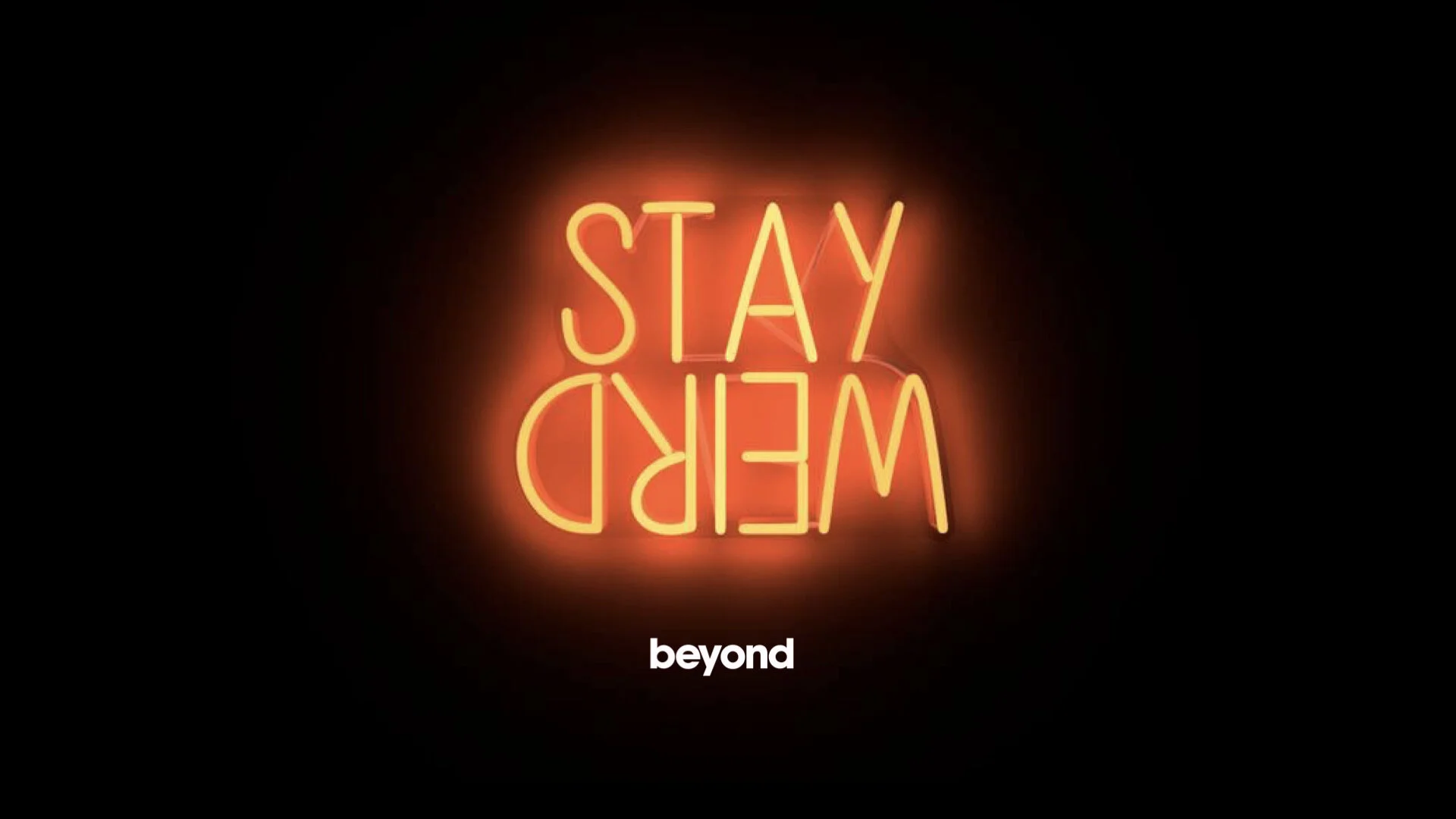APPLIED CREATIVITY
Defining a digital agency’s approach to creativity and idea generation
Project date: 2013-2023
IN A NUTSHELL
I co-designed my last agency Beyond’s creative process inspired by theories and methods used at Hyper Island, Kaospilot, Stanford D-School and IDEO.
Subsequently I was promoted to a role as Beyond’s first Idea Agent. It was my responsibility to design workshops and facilitate groups during the ideation phase of projects and pitches coming through the London office. I also travelled to and trained all of Beyond’s 250 employees across their offices in the UK and US.
Based on this internal creative process, which we called “Applied Creativity”, we designed two new client facing services:
The first was a rapid idea generation training program. We taught our client’s teams:
How to synthesise overwhelming amounts of research into inspirational focus questions,
The key creative principles essential to stimulating idea flow
Fail proof idea generation methods that create hundreds of ideas in minute.
The second service was a custom designed collaborative idea generation workshop where Beyond employees would join our client’s teams and idea generate solutions to key business challenges.
Both of these services could span from 1 to 5 days depending on the client’s needs. I led and helped sell over 30 of these workshops to product and innovation teams within companies including Novartis, Google, NPSCC, UBS, AKQA, News Corp, Virgin and MoneySuperMarket driving revenues of over £2m.
MY ROLE
Instigator
Having joined Beyond straight after my MA at Hyper Island I noted that they had chosen not to set up a traditional “creative department” yet lacked an effective ideation process that could bring together and maximise the creative potential of employees across disciplines within their organisation. I convinced the London General Manager, Head of Strategy and Head of Client Services to let me use Hyper Island style creative methodologies on a key project with Novartis. The success of this project provided the support and mandate to fully redesign the agency’s creative process.
Co-designer
I wrote a 1st Class MA dissertation on how digital agencies (and more specifically Beyond) could foster a culture that supports effective creative collaboration. In addition to this I explored creative processes used by top digital, design thinking focussed institutions including Hyper Island, IDEO, Kaospilots and Stanford D School. Beyond London’s General Manager and I used this research together with our understanding of recurring pain points Beyond and our clients were experiencing during the ideation phase of the design process to create our own methodology which we called ‘Applied Creativity’.
Lead facilitator
I designed and lead facilitated over 30 applied creativity workshops with clients and even more internally at Beyond. I also acted as strategist on many of these projects, often working with data analysts, producers, account managers, UX’ers and the client to ensure we had researched and defined ‘the problem’ accurately enough to be able to proceed with creating the most effective solution.
New Business & Marketing
Taking arguments from my MA dissertation, I ghost wrote an article for one of Beyonds co-founders promoting the power of collaborative creativity which featured on the homepage of AdAge.com (link here). Subsequently I helped sell over 30 of these workshops to clients from Novartis, Google, NPSCC, UBS, News Corp, Virgin (see project here), MoneySuperMarket and more.
Coach
I trained every Beyond employee how to use and many how to facilitate these methods. I also gave extensive training to some clients who wanted to run their own workshops. This included SVP of Product at 21st & 20th Century Fox, Mitchell Linden who wrote:
Alex is a fantastic asset to have around any group of people driven to do great things. He brings a wealth of knowledge about "idea thinking" to any situation where people are working to solve problems, create products, or just trying to find their through the murkiness of exploring what might be. I've had the pleasure of working with Alex where he has led creative exploration exercises, and I've also tapped his vast knowledge in crafting my own design thinking sessions. Alex is super smart, creative and generous. If you appreciate the process of creation, and working with others in a really positive and effective way, Alex Hunting is a great guy to have around.
HOW DOES THE PROCESS WORK?
Every workshop follows the same 8 stage process although the amount of time spent on each stage is tailored to the given client and brief.
For companys who’s main focus was building skills within their teams, more time would be allocated to creative principles and focus questions. We would then use a dummy brief which allowed the participants to push their creative boundaries using the idea development methods and enrichment sheets. We would also provide facilitation training so each participant would feel confident running these exercises themselves within their teams and future projects. These workshops took a half or full day.
For clients focused solely on quality ideas we would build and refine the brief with them before the workshop so we could ensure the focus questions were accurate and inspirational. During the workshop the majority of the time would be allocated to idea development and enrichment although invariably participants would comment on the impact that the creative principle exercises made on them so we would include them if only briefly. These workshops would take anywhere from two to five days.
INTRODUCING THE SESSION
The ‘Intention’ and ‘Desired Outcome’ slides reflect the priorities of the client as stated prior to the workshop.
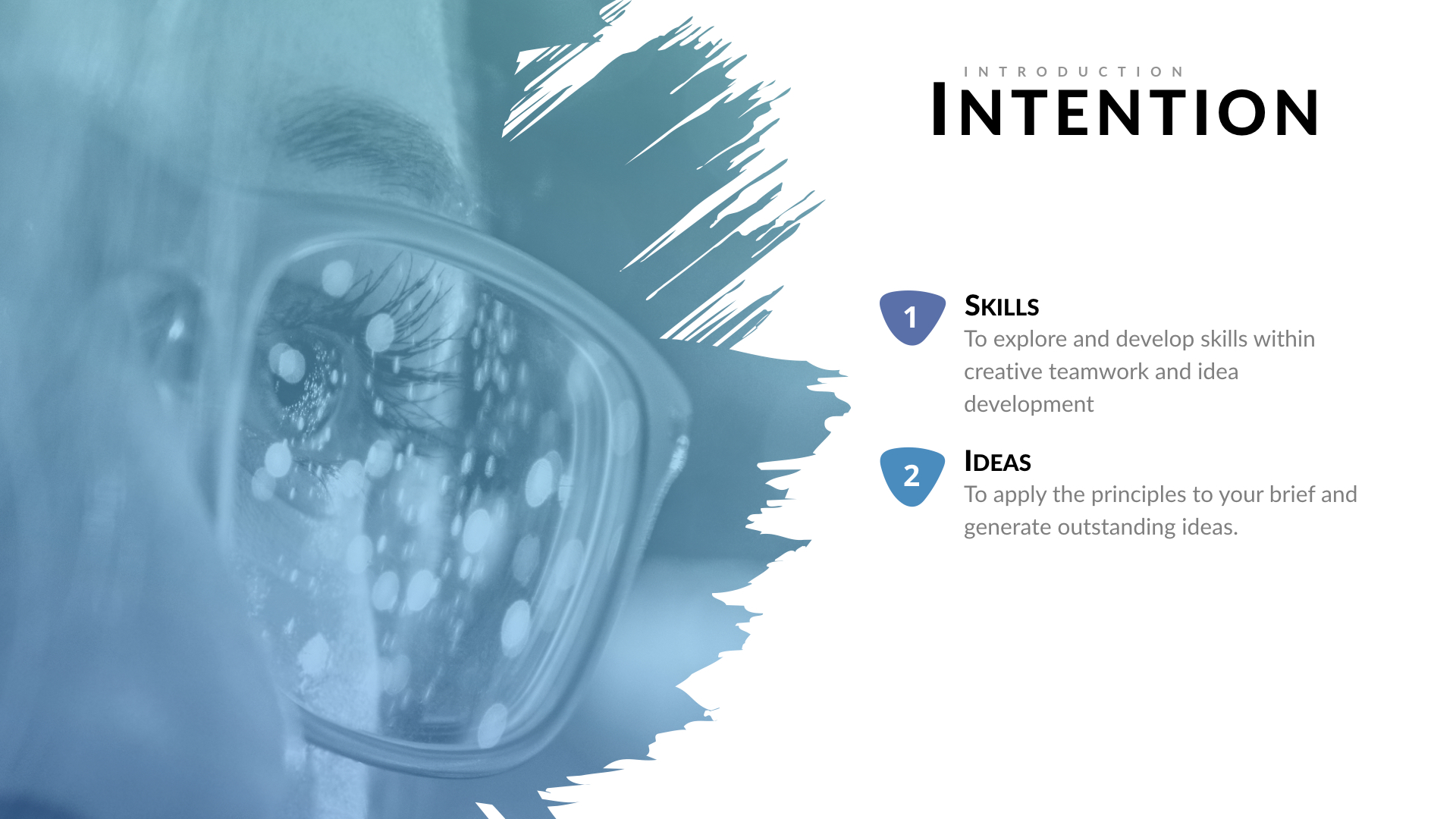
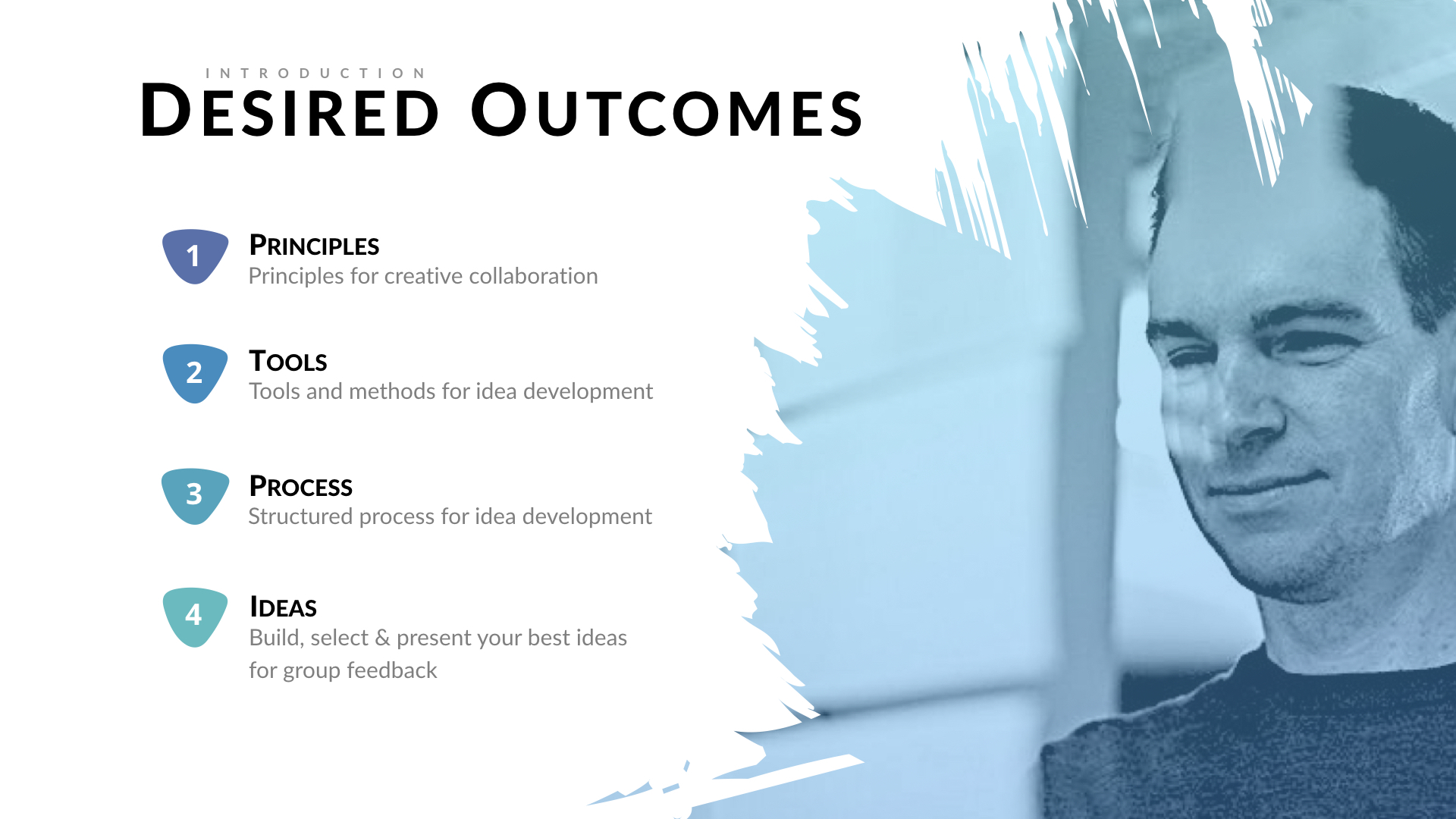
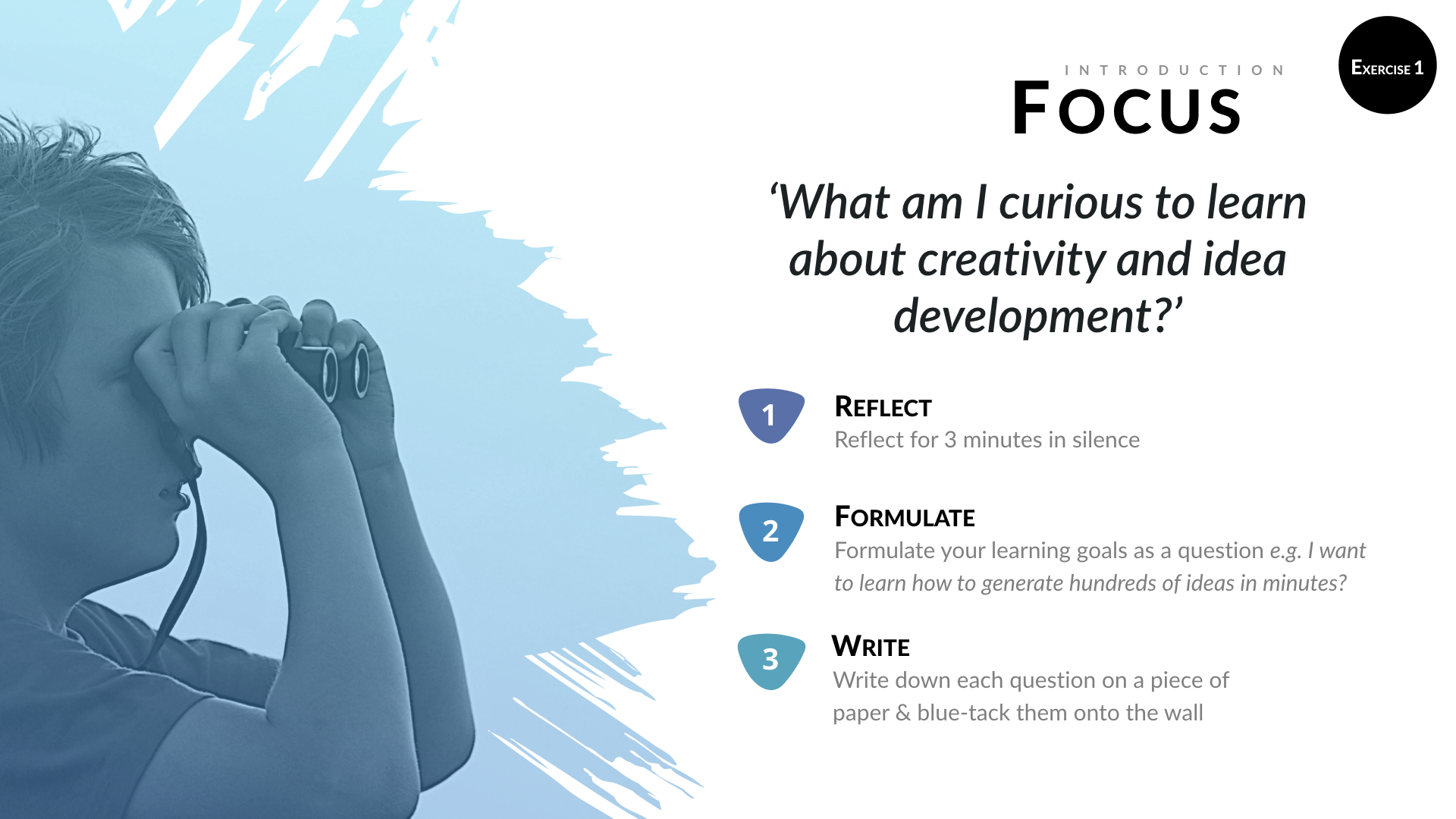
We then asked the workshop participants to consider: ’What am I curious to learn about creativity and idea development?’ They were asked to formulate questions they might have, write them down on paper and stick them up on the wall. (For example “How can we prevent our creative thinking from being constrained by budgets, red tape or legal requirements?) Once all the questions were stuck on the wall we would allow the group to look at each other’s questions for a minute then move on without any discussion.
Asking the workshop participants to reflect and write their own questions helped us to understand any underlying issues, frustrations or pain-points facing the company that our client contact may not have identified prior to the workshop. Forcing participants to focus on their own learning goals and pain points at the start of the workshop often resulted in each individual discovering their own answers as we went through the workshop. In fact at the end of the workshop we would ask participants to look back at these questions and take them off the wall if they had been answered. Invariably 95% of the questions would be taken down.
HOW WE WILL WORK?
These “How we will work?” slides acted as a ‘social contract’ which were tacitly accepted by each participant and set the tone for the rest of the workshop.
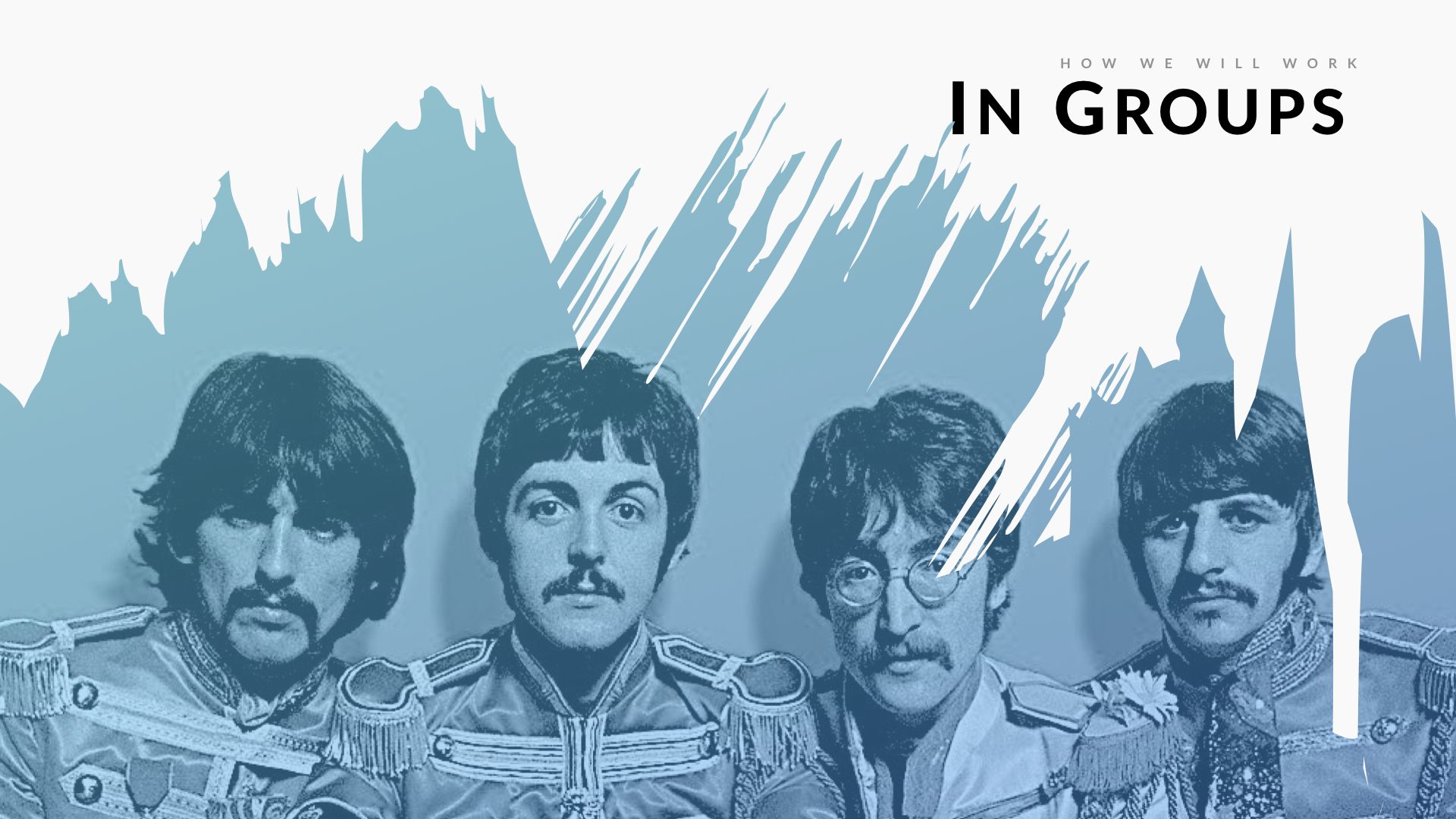

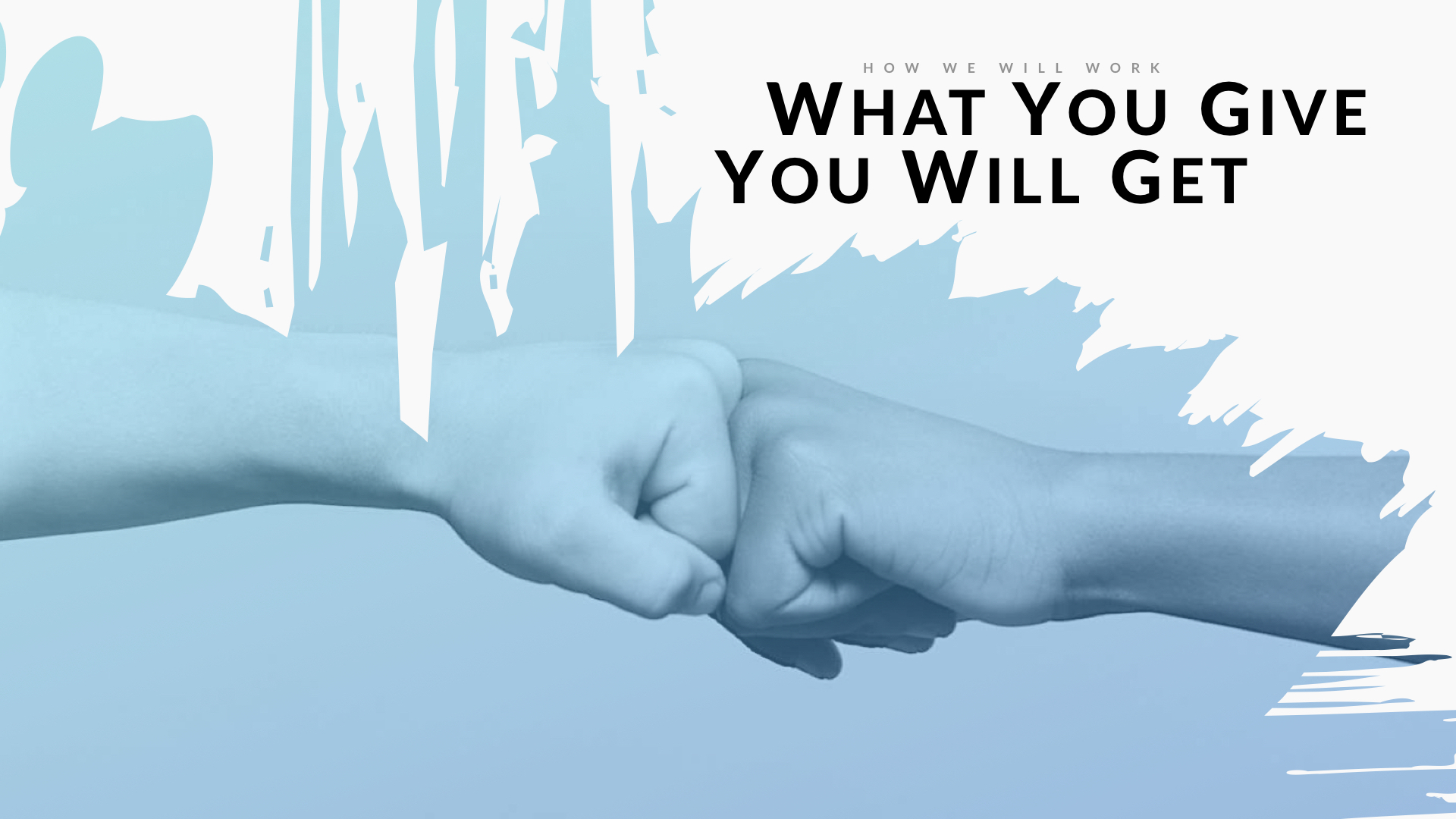
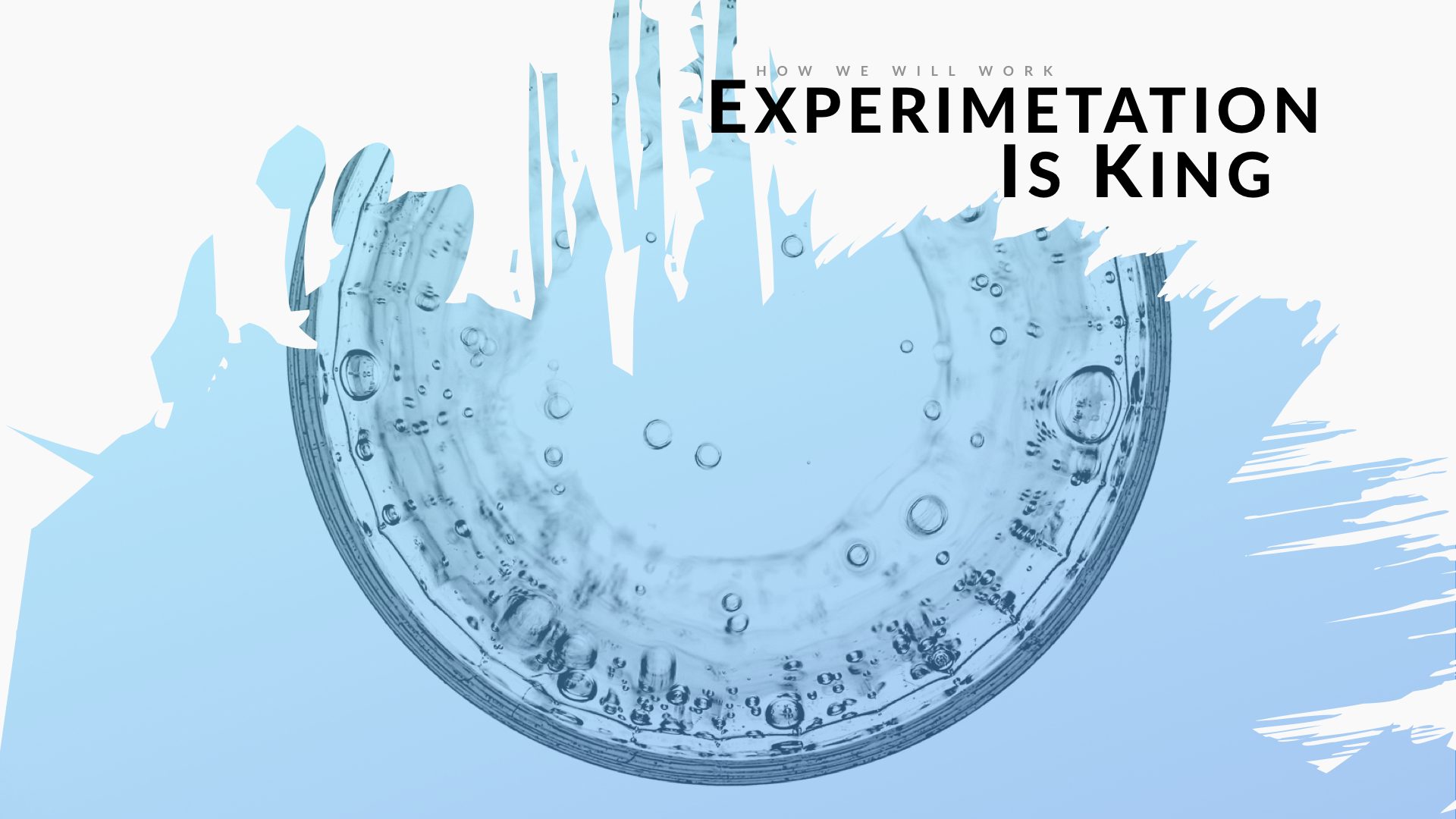
CREATIVE PRINCIPLES
These two exercises never failed to make a big impact as they made the creative principles self evident to the participants once they had completed them.
The apple game: Invariably each team ‘drawing apples’ would follow the same pattern. The first row or two of apples drawn would be very literal depictions of apples eg. A whole apple, half an apple, an apple core, an apple with a worm. As the the team relaxed, built confidence, became inspired by each others drawings and ran out of obvious apple drawings they would push the definition of ‘an apple’ within their drawings. Eg. NYC ‘the big apple, ‘apple of my eye’, Apple computers, Adam’s apple.
At the end of the exercise when we asked each team to compare their apple grids with other teams in the room and reflect on the exercise the trends became self evident. Participants would comment ‘The early apples are all the same but we got more creative as we drew more’ or ‘I was inspired by what I saw other people drawing’.
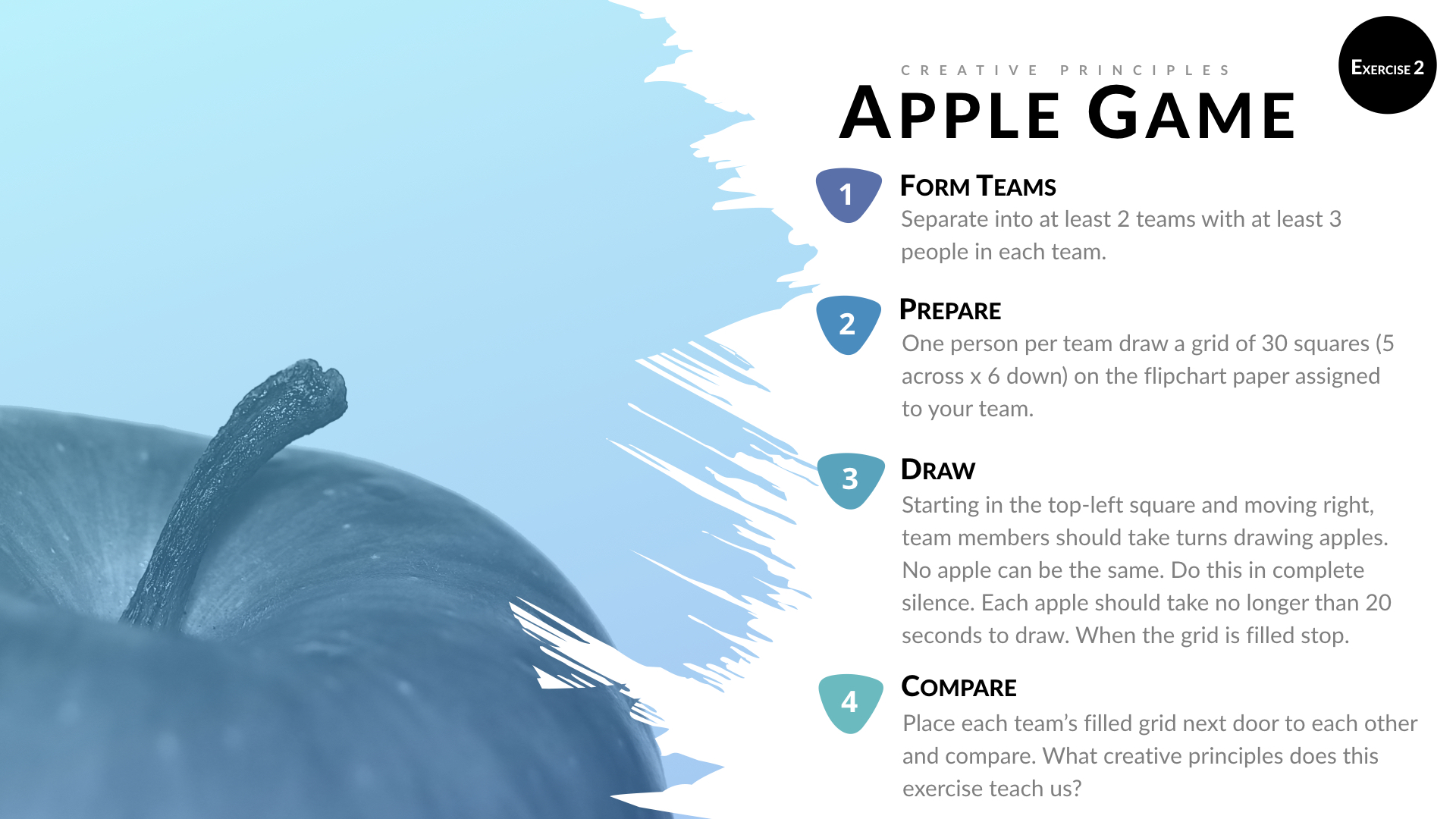
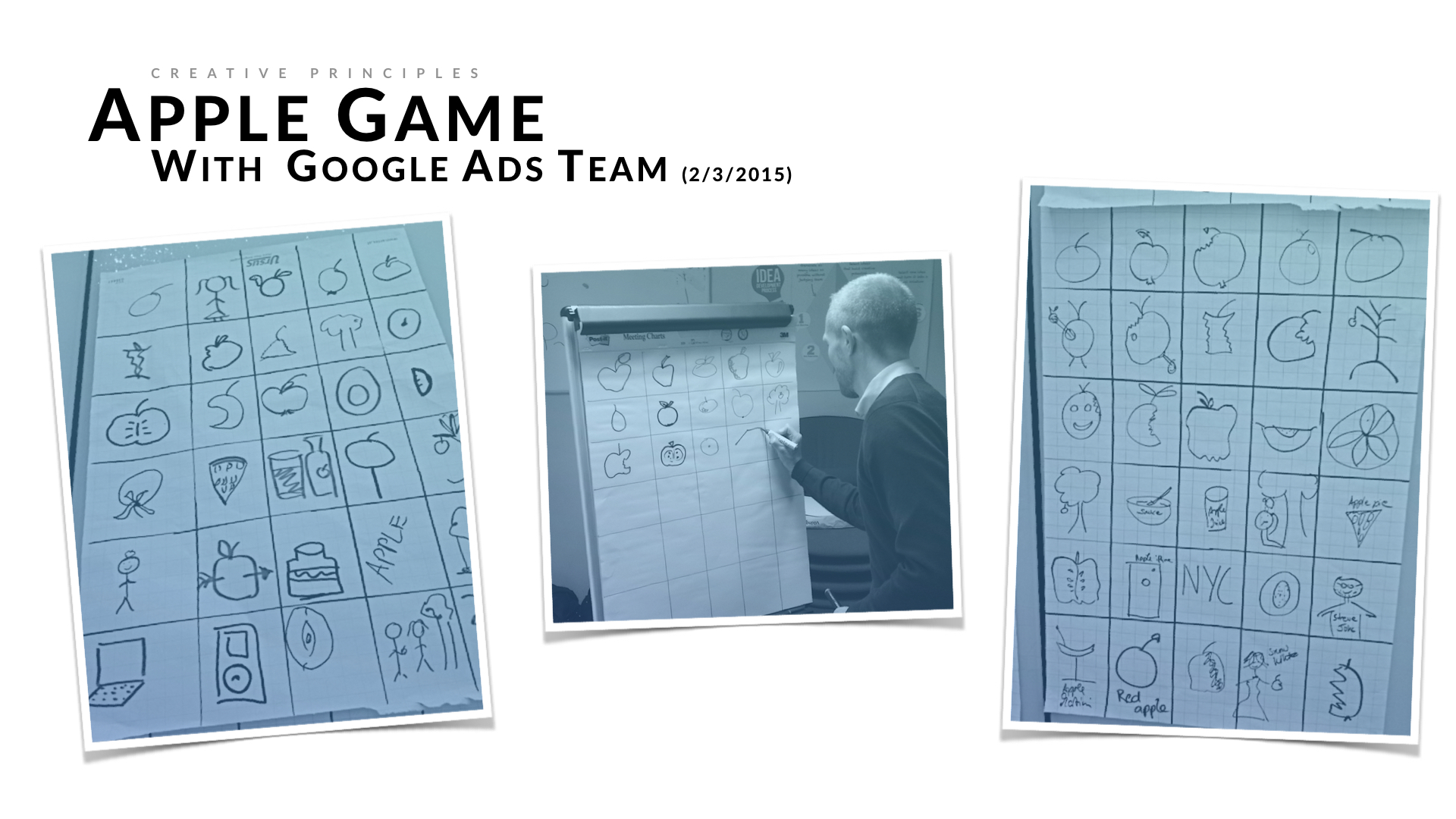
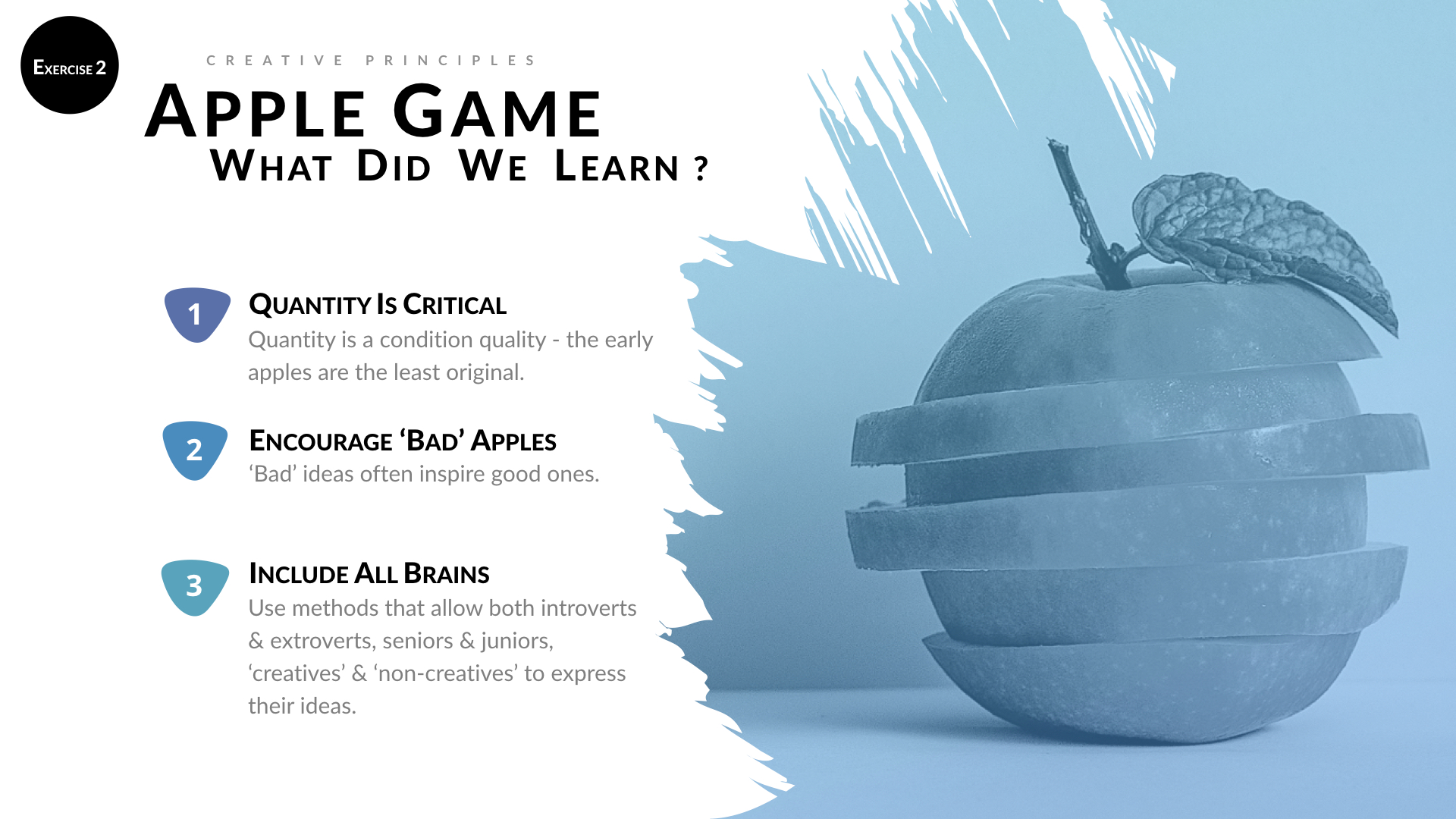
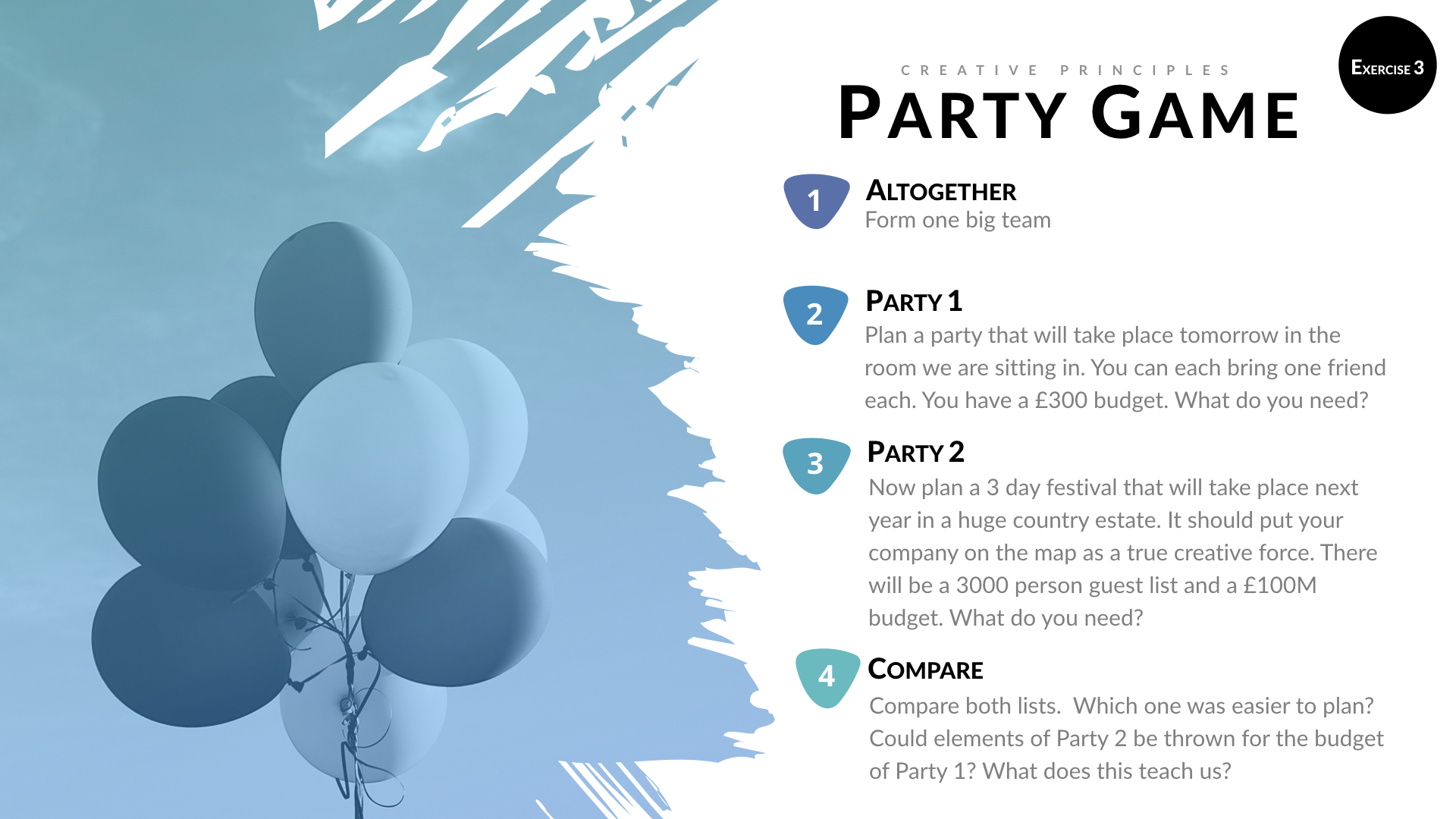
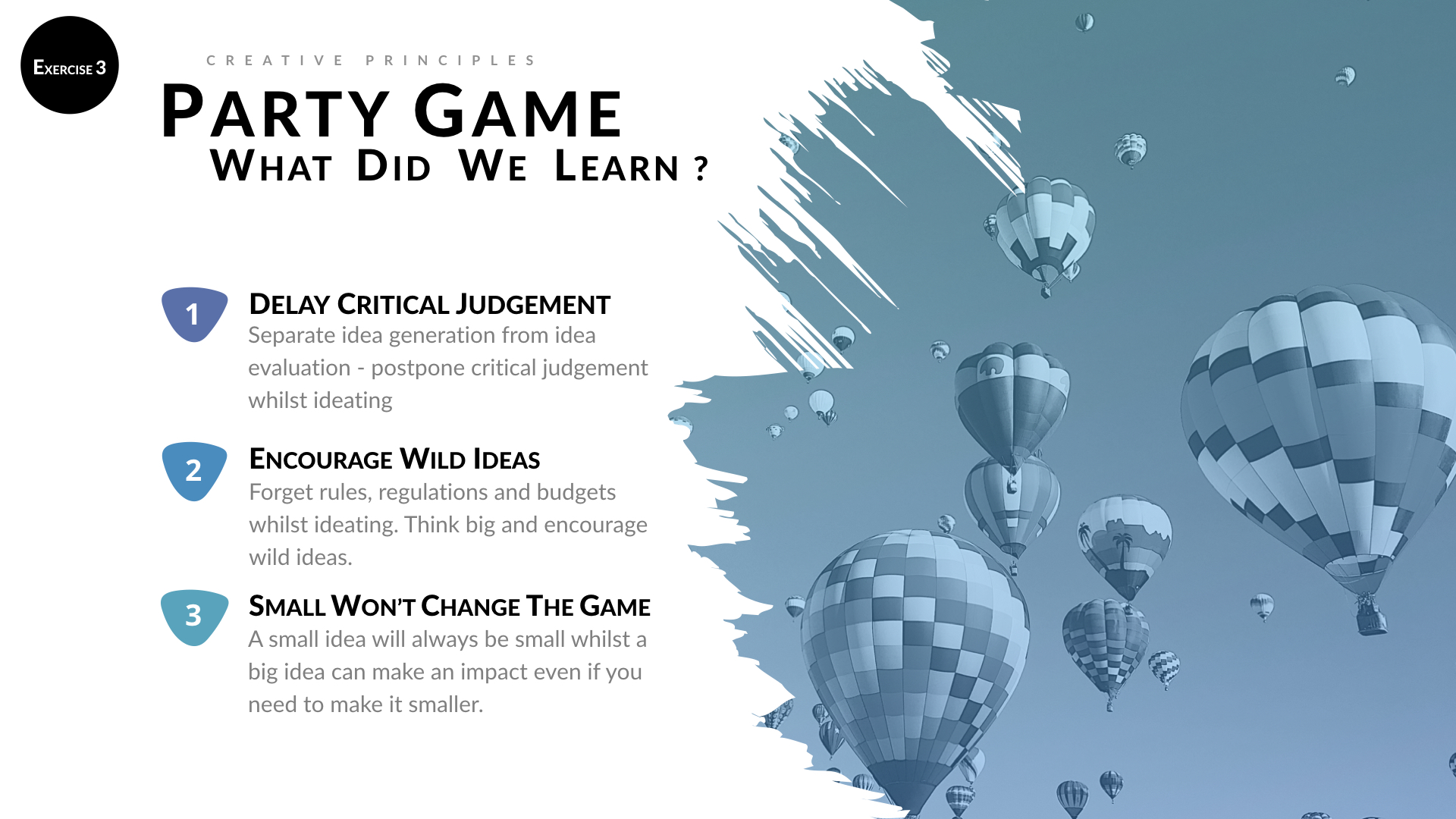
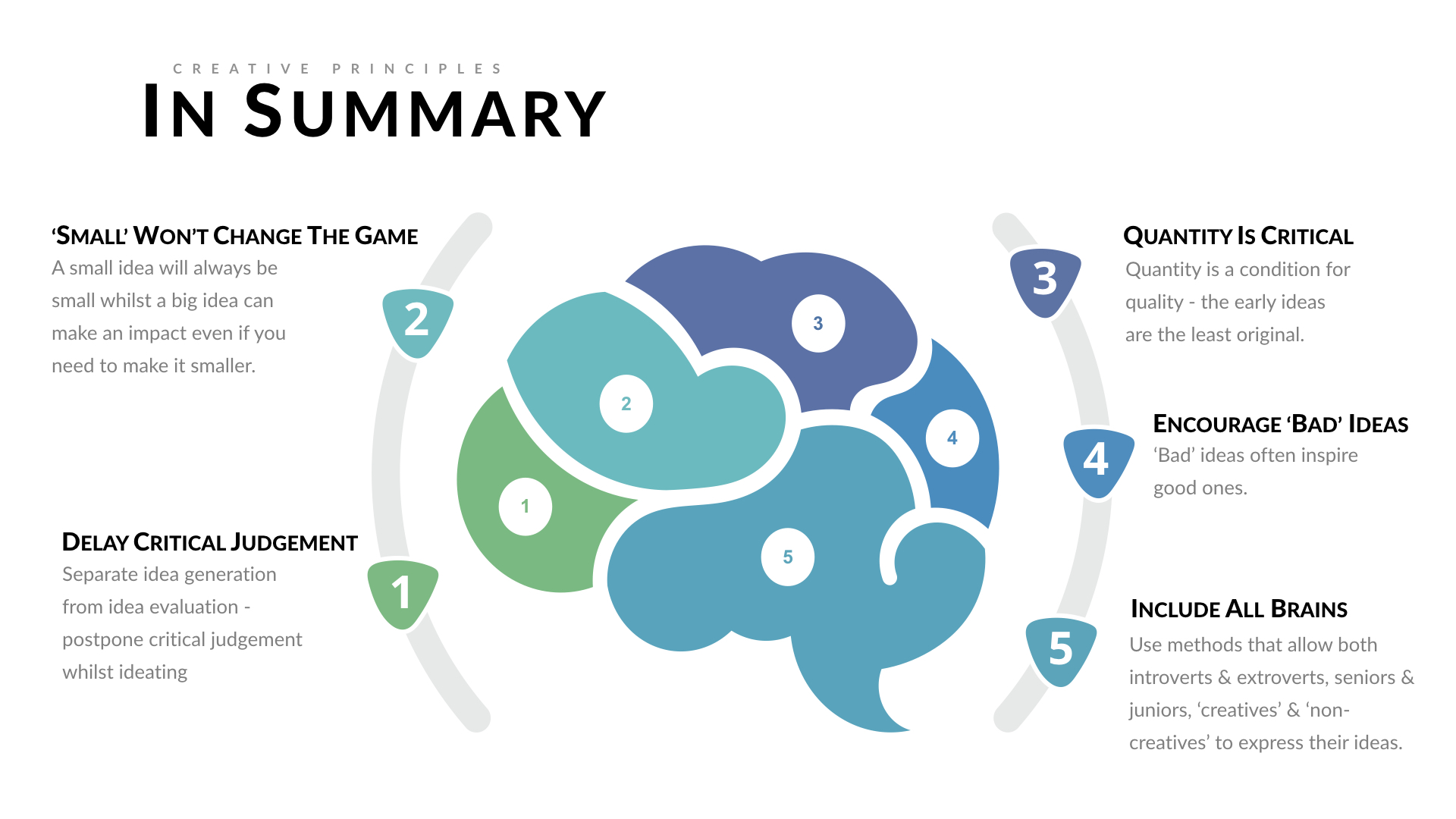
The party game: We’d ask all the participants to take part in the this exercise as one team. For the £300 party we’d get the obvious bland answers: balloons, speakers, nibbles, drinks, email invitations…… When asked to plan the £100M party we’d much more creative suggestions: fireworks, food cooked by celebrity chefs, the rolling stones playing live, animals parading down the streets, a champagne fountain.
Then we would ask the group which party was easier to plan? The more regulated, stale cultured companies would say Party 1 because “we’ve planned that kind of party so many times before”. More creative companies would prefer planning the wilder second party without limitations.
Then we asked could we throw the second party with the limitations of the first party? “Well……maybe…we could take inspirations from the second party…” How? We could project a YouTube video of fireworks, cook our own food using celebrity chef recipes, play a Rolling Stones Spotify playlist, dress up in animal costumes…..
STRUCTURED IDEA MANAGEMENT PROCESS
A key goal of this workshop was to give confidence to participants who didn’t deem themselves to be ‘creative’ and deferred the opportunity to generate ideas in their everyday roles.
Creativity is the ability to juxtapose two or more experiences / concepts / patterns together to form an original combination…. also known as a new idea.
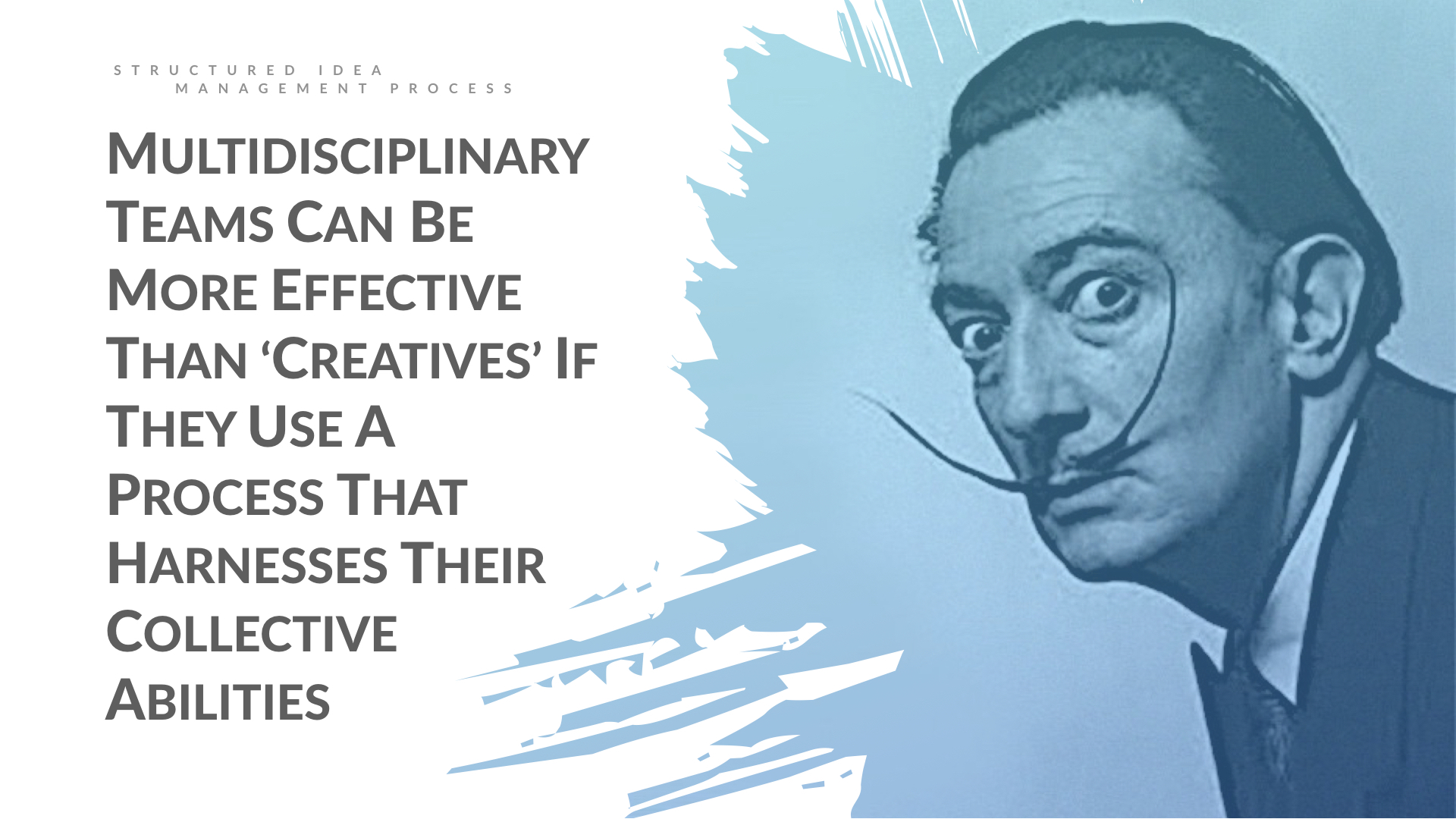
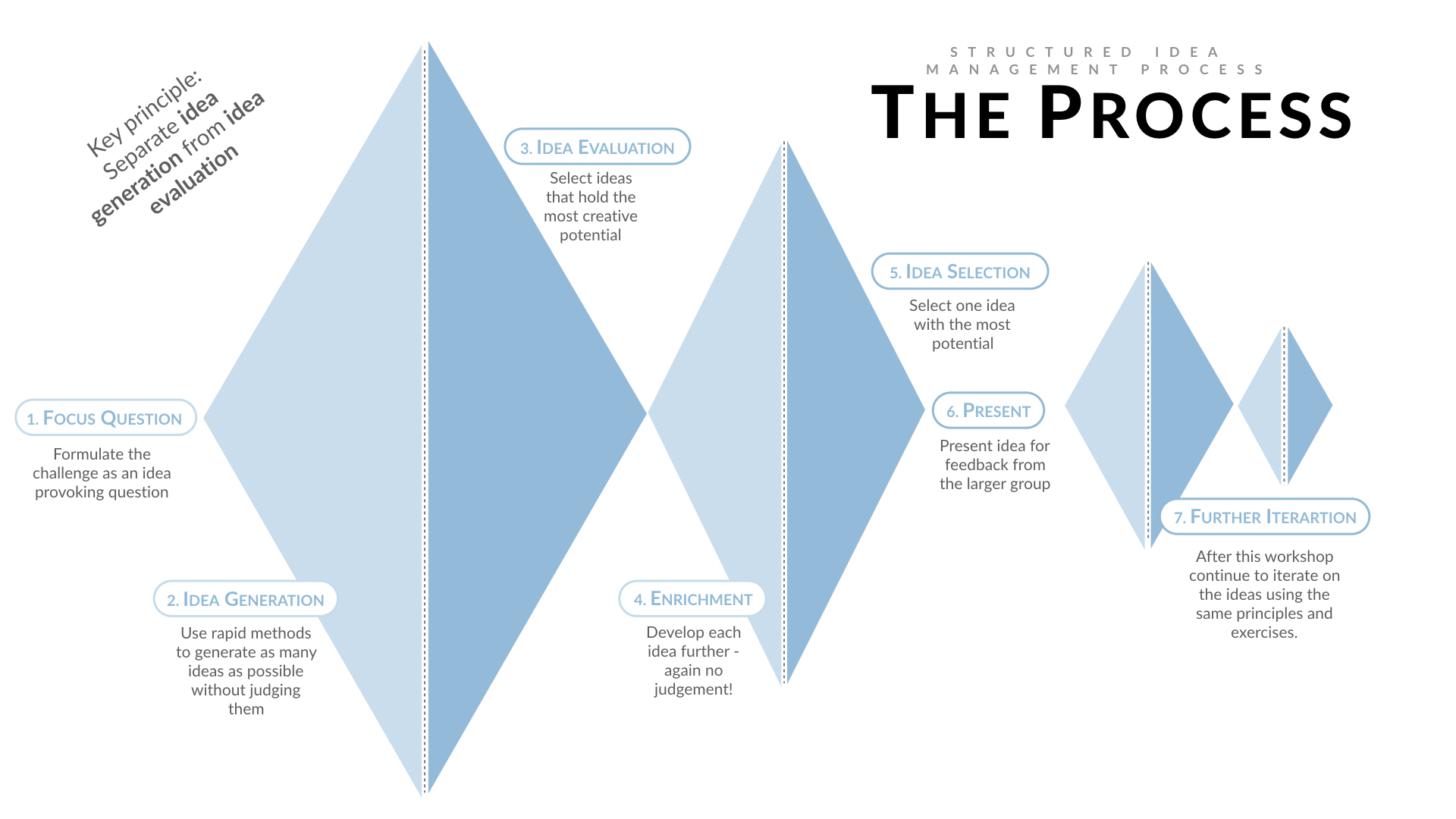
In today’s complex digital environment very few individuals have the a wide enough array of skills and experiences to generate transformational ideas. Multi-disciplined teams with ta wide array of skills, cultural background and experiences working effectively together using a systematic creative process will outperform creative individuals.
Structured Idea Management Process - The six stages of the process that took place during the workshop rely on each participant shifting between divergent and converge thinking by separating creative and analytic thinking.
FOCUS QUESTIONS
The quality and relevance of the ideas rely heavily on how accurate and inspirational the focus questions are. Defining them correctly is the most important part of the pre-workshop preparation. They provide the synthesis of all the research done whilst also defining the creative permitters.
Great focus questions are built on key insight. An insight seeks to understand 'the why' rather than 'the what'. Why do people think the way they think or do the things they do...... as opposed to what they actually end up doing.
Data tells us the world the way it is and the insight looks at why the world is that way so that the real needs of people can be unveiled and met by the products / messages we produce. Most of the time there may be multiple insights that can be drawn from a brief.
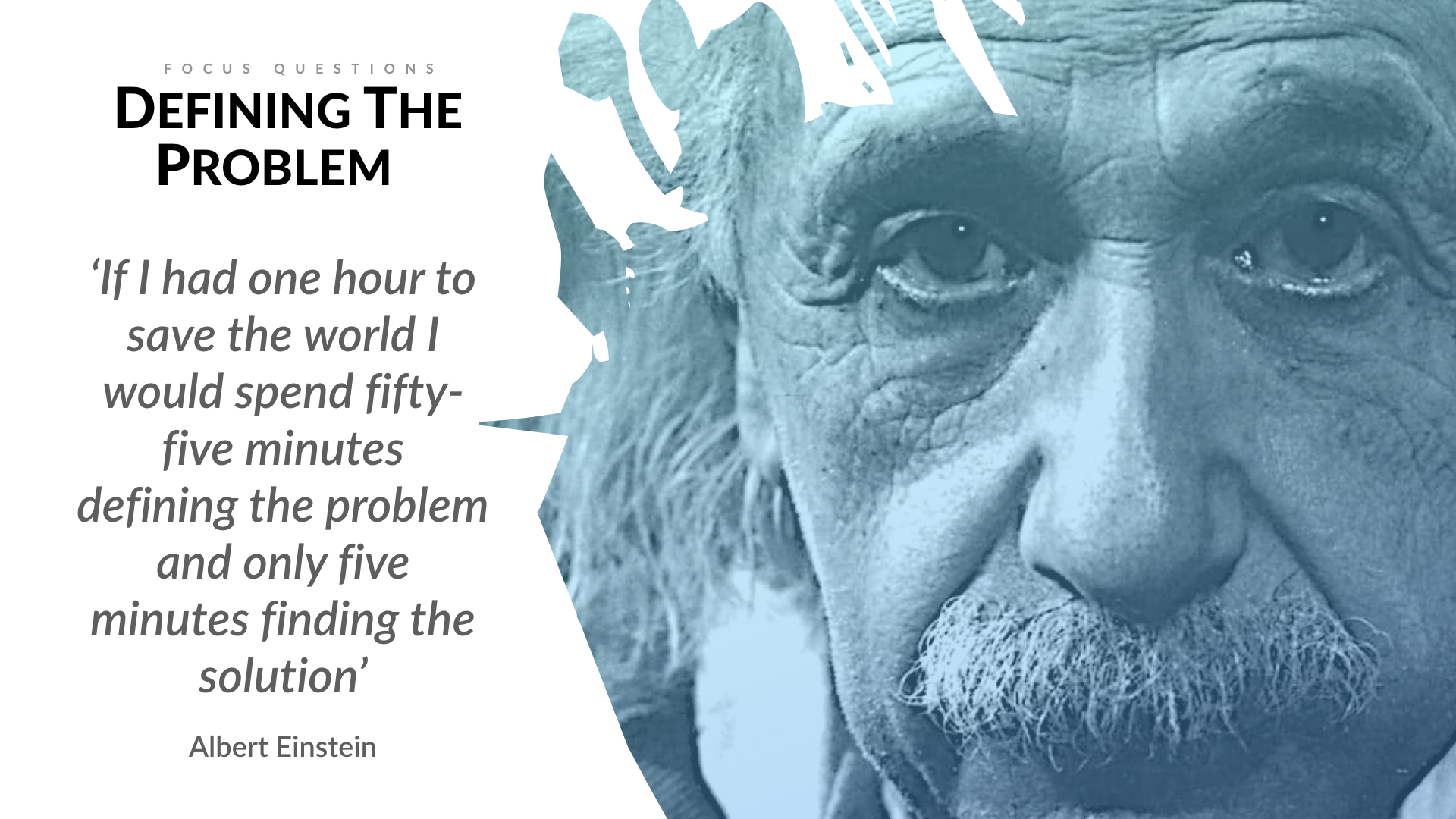
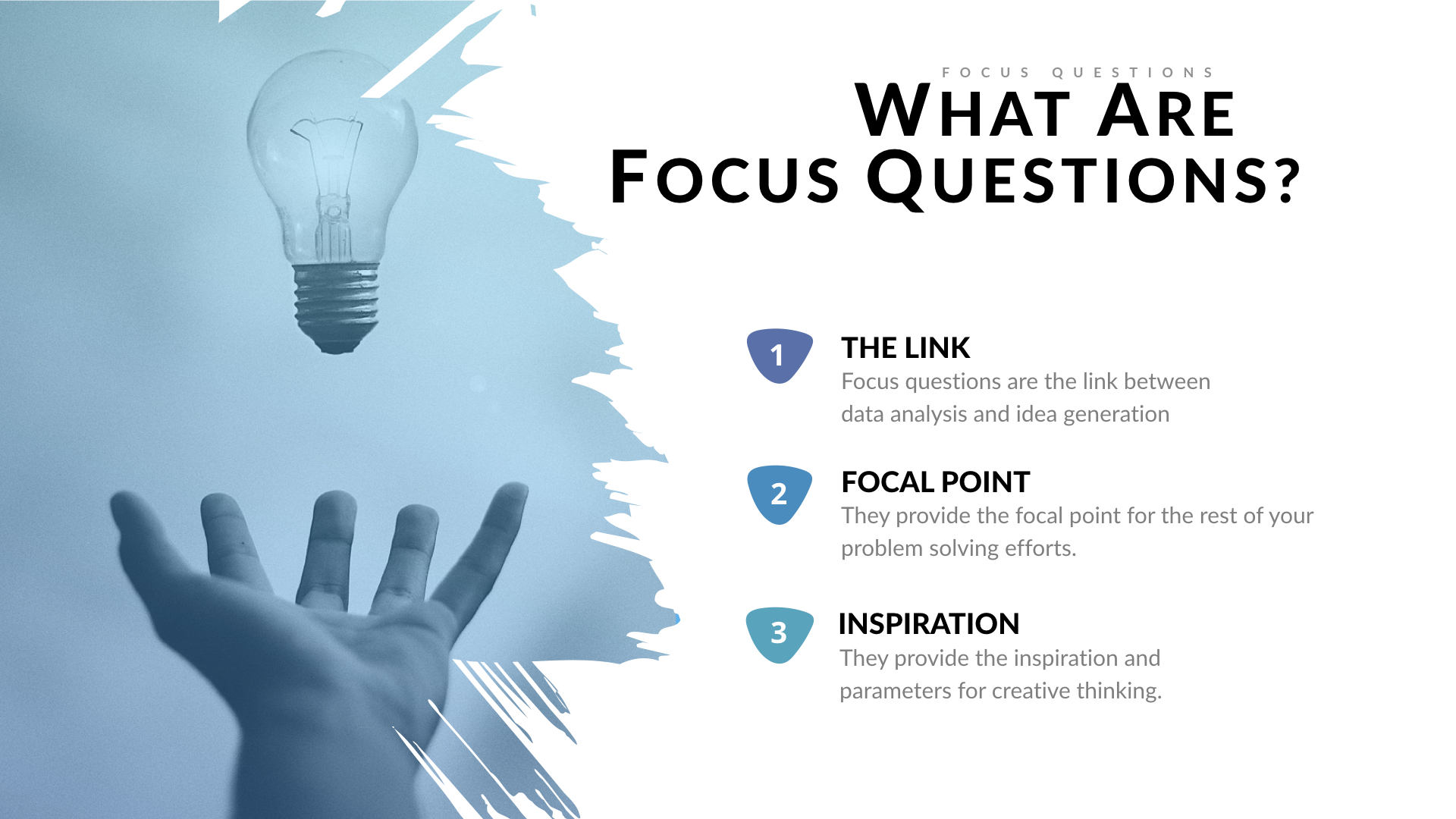
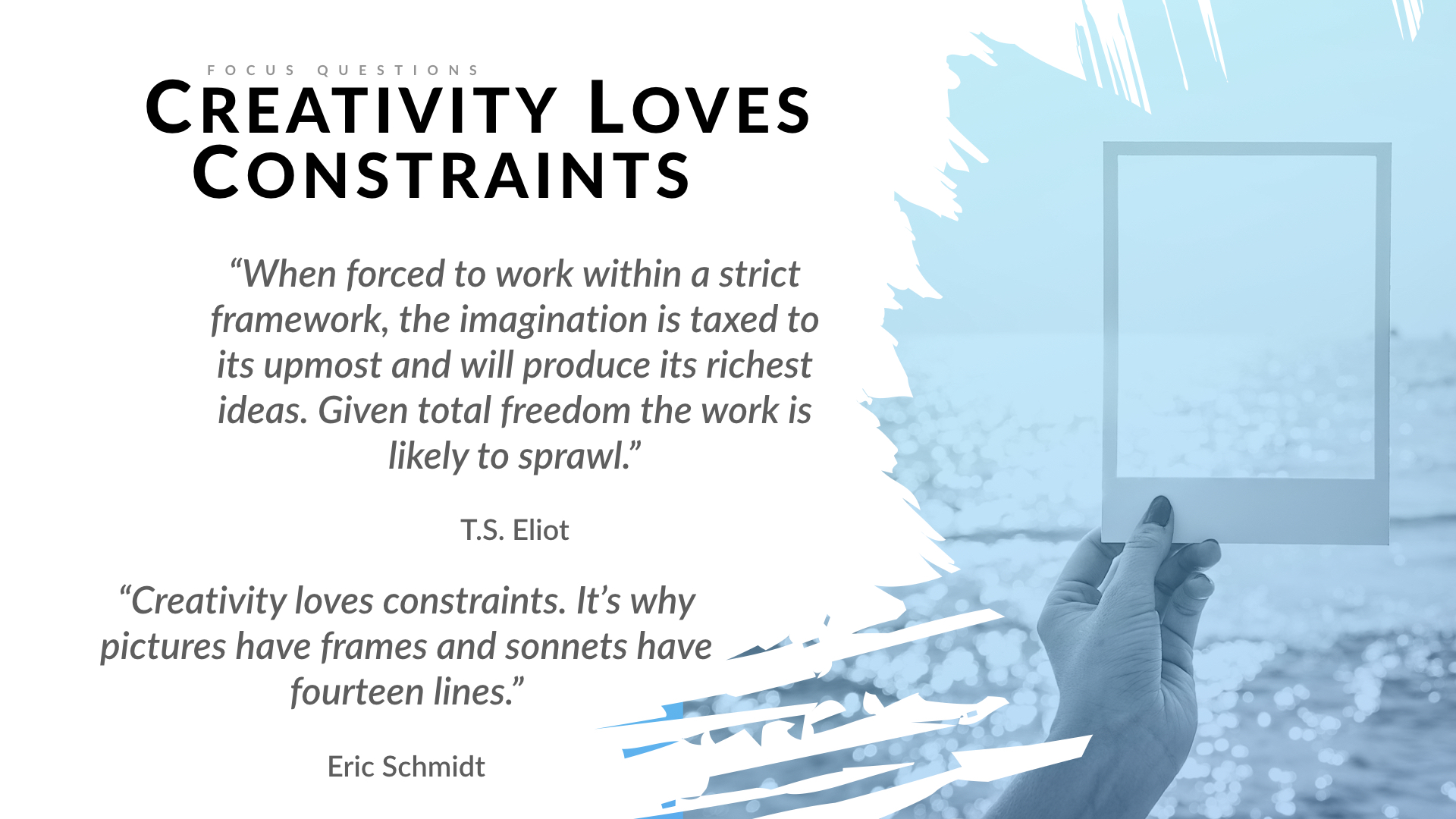
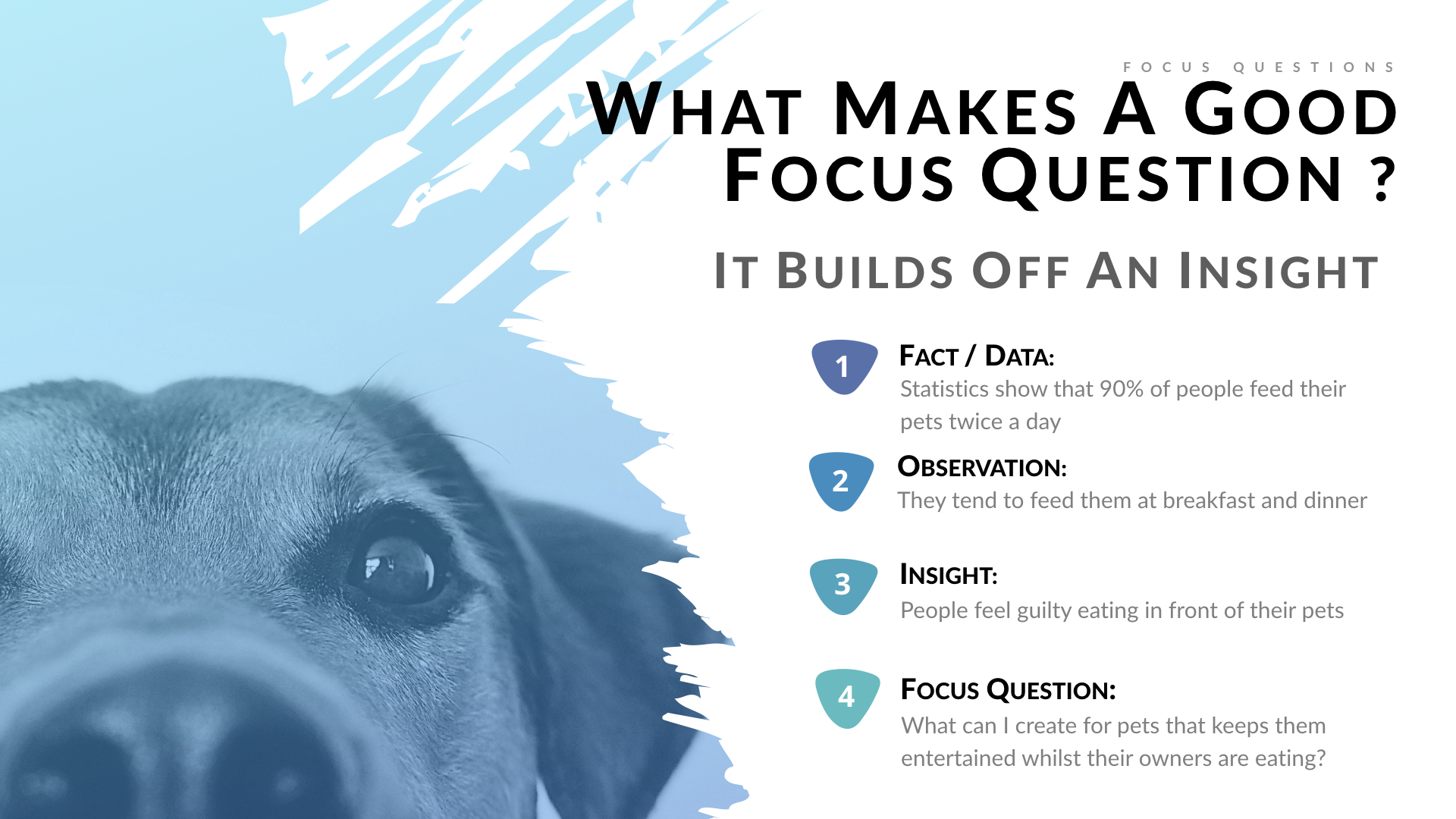

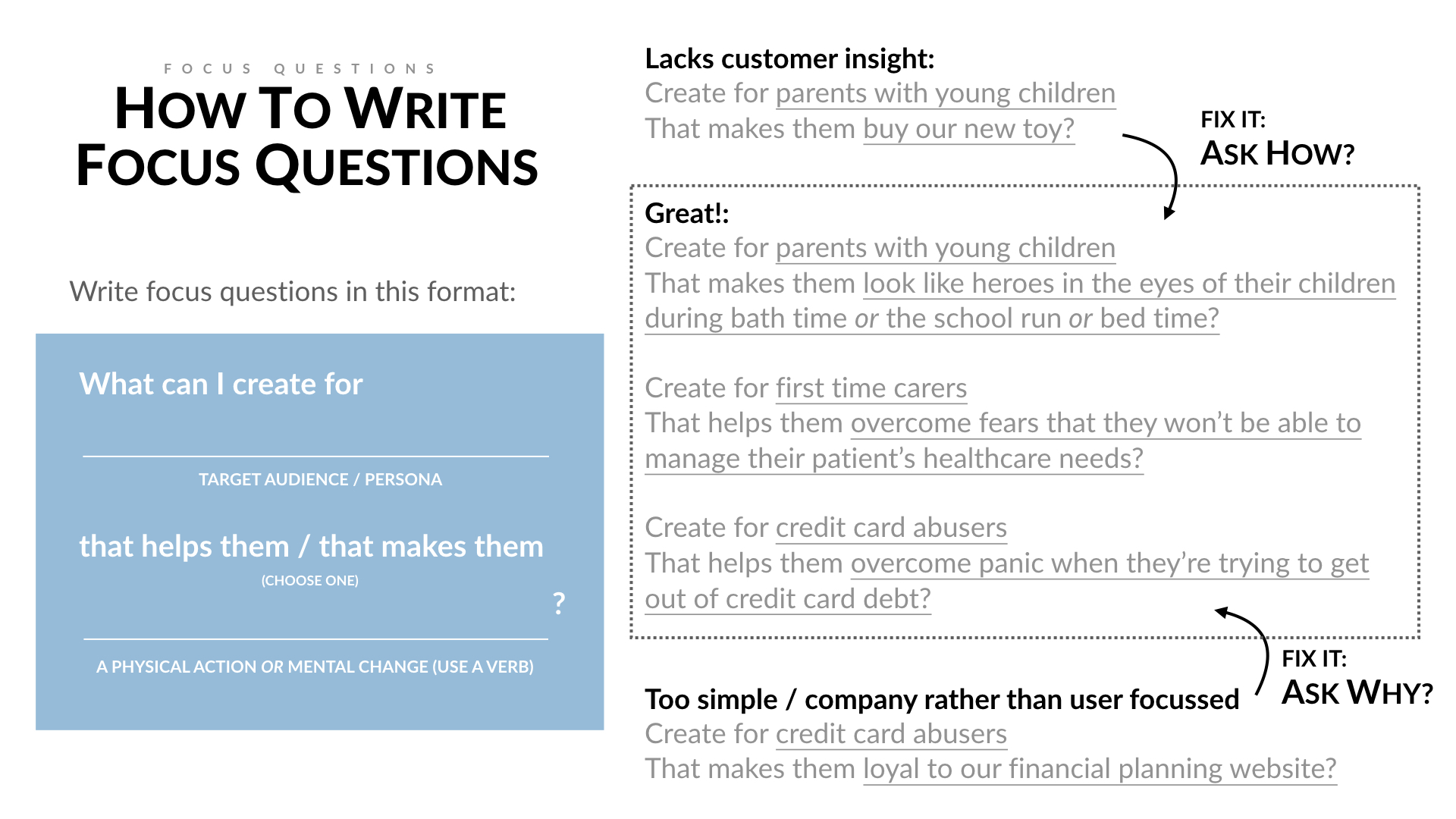

THE BRIEF
We would provide the participants with the project goals, a deep understanding of the target audience as well as key research insights form which we has created the focus questions.
For workshops where the quality of ideas was the main goal, we achieved the best results when we included participants who knew very little or nothing about the project up to this point. This brief would give newcomers enough understanding to participate effectively without restricting their creativity by overloading with current thinking that the dedicated project team might have been biased towards. Often we also included end users in as well to get their had on perspective.
IDEA DEVELOPMENT
Before starting idea generation we review the focus question for the session and stick it on the wall so participants are constantly referring to it. We also split the group into smaller, more effective team sizes (4-6 people / team) for the rest of the workshop. We ensure that each team has a cross section of skills sets, seniority, genders and experience with the brief.
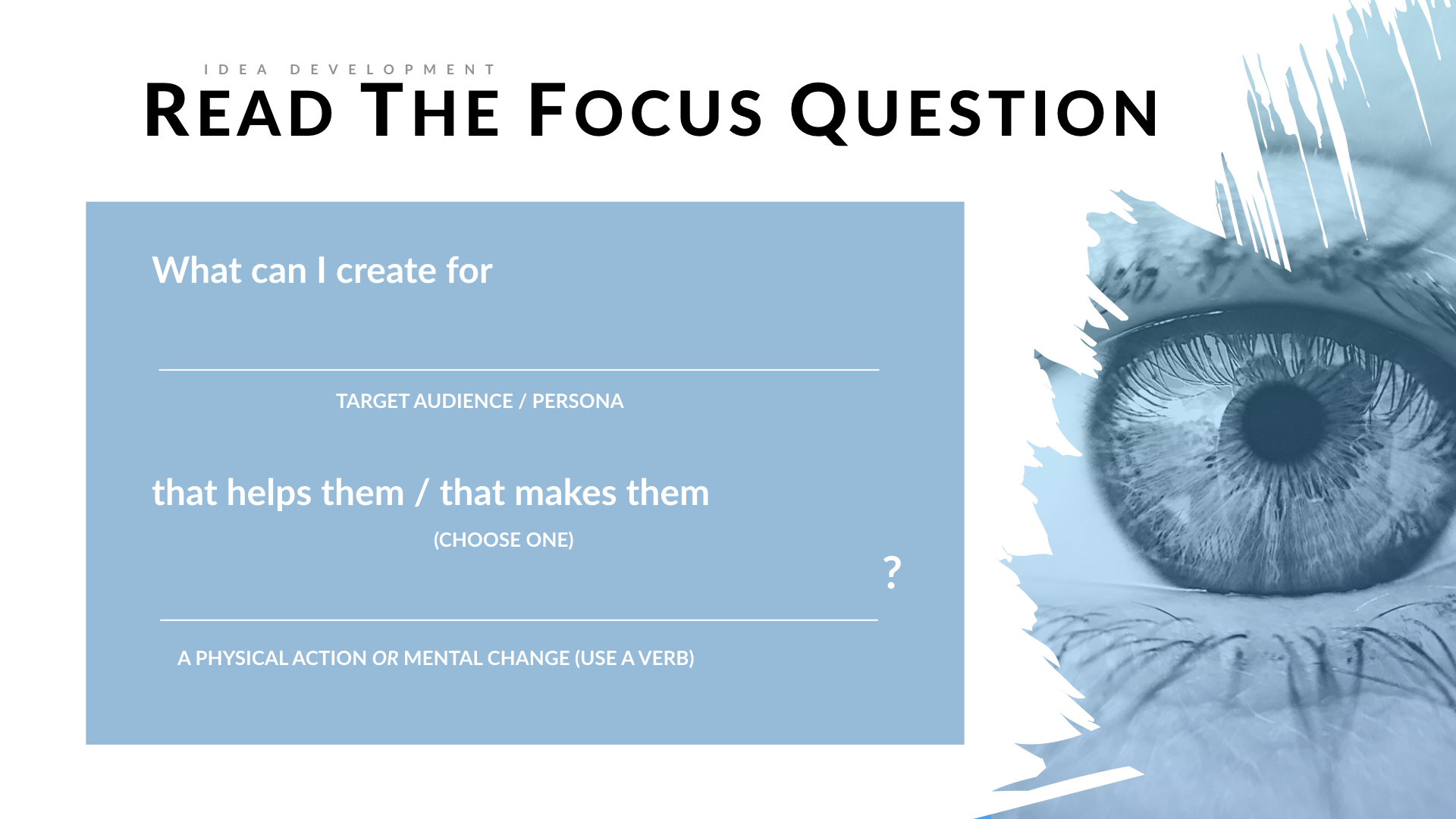
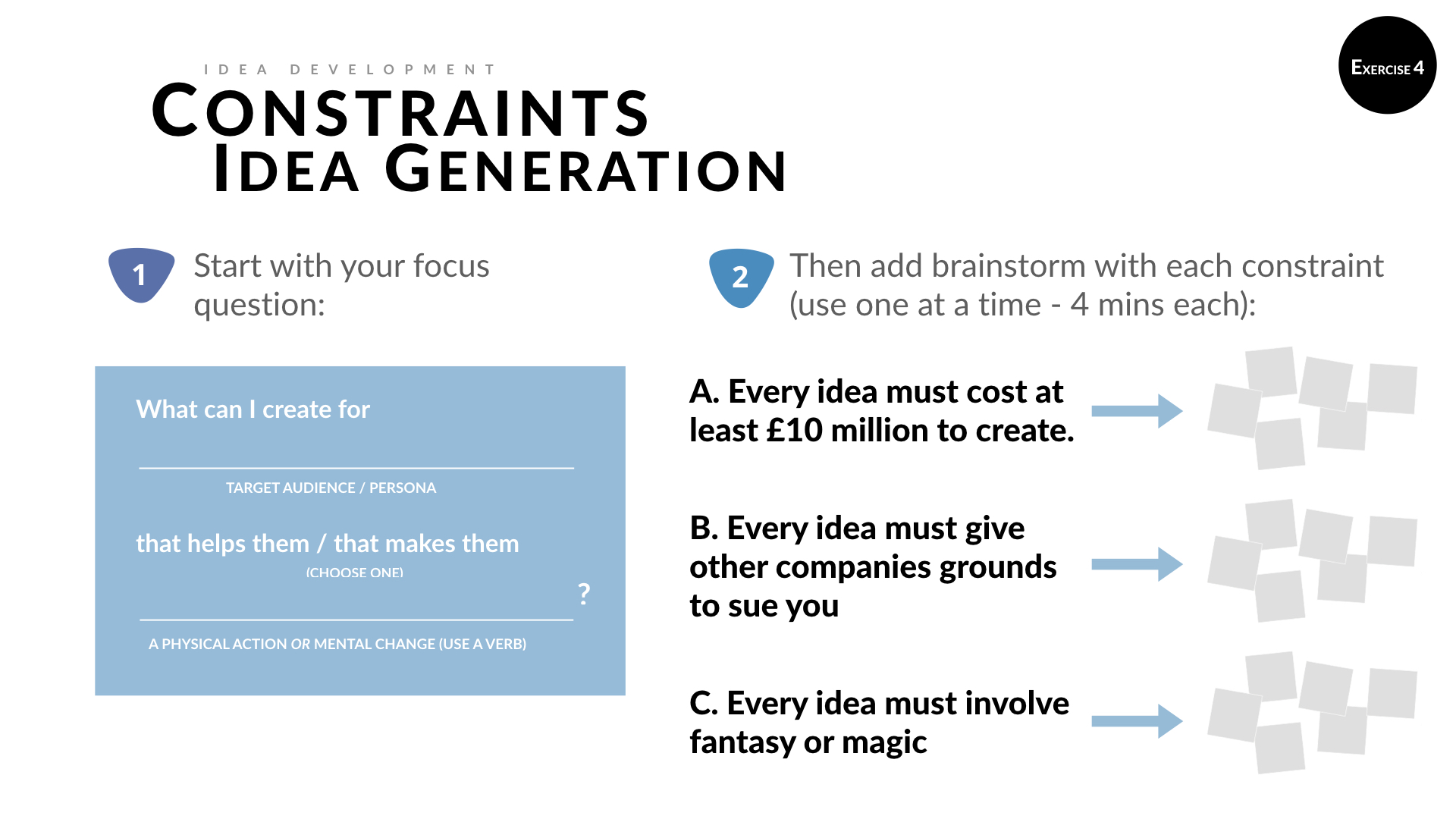
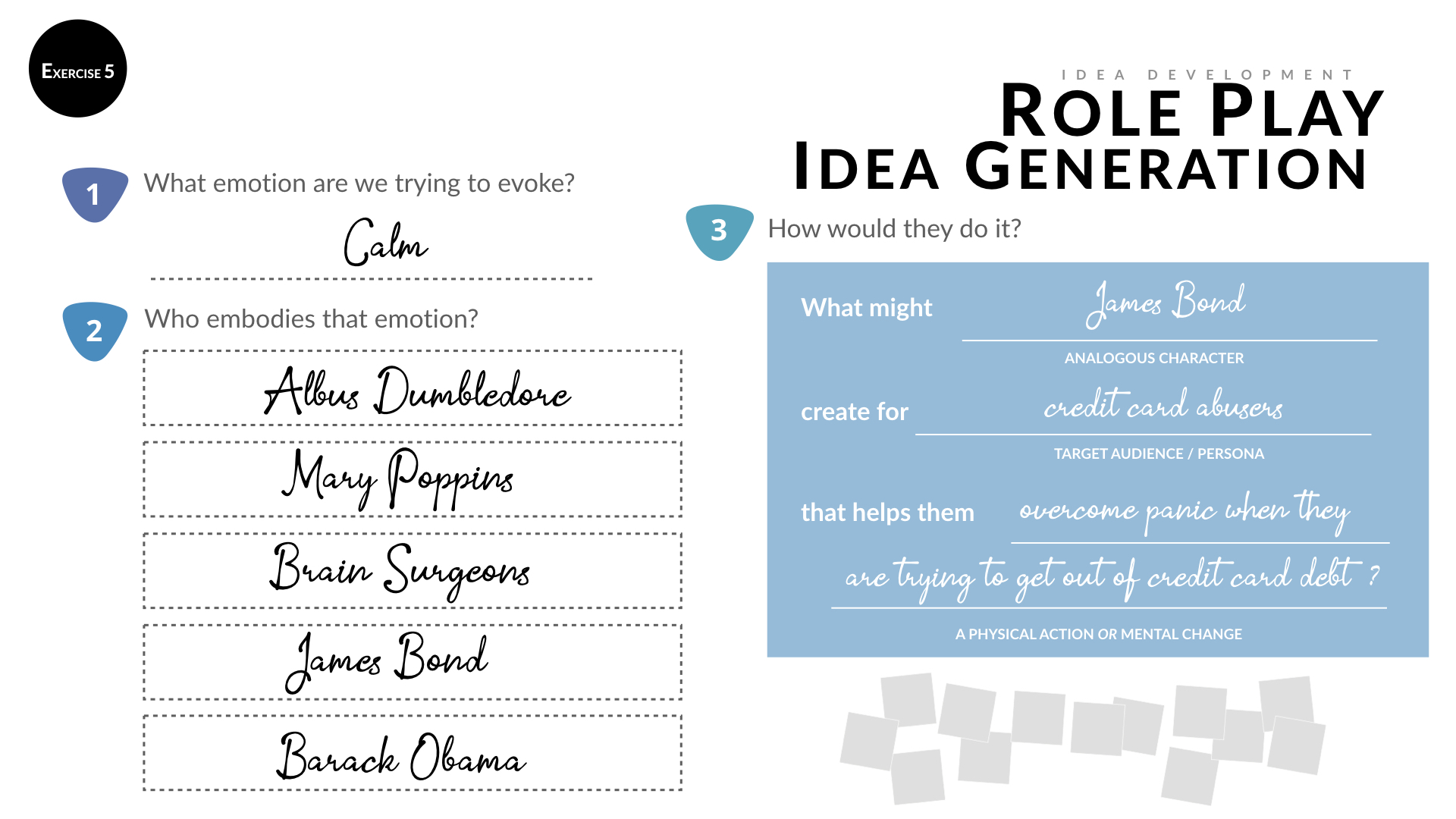
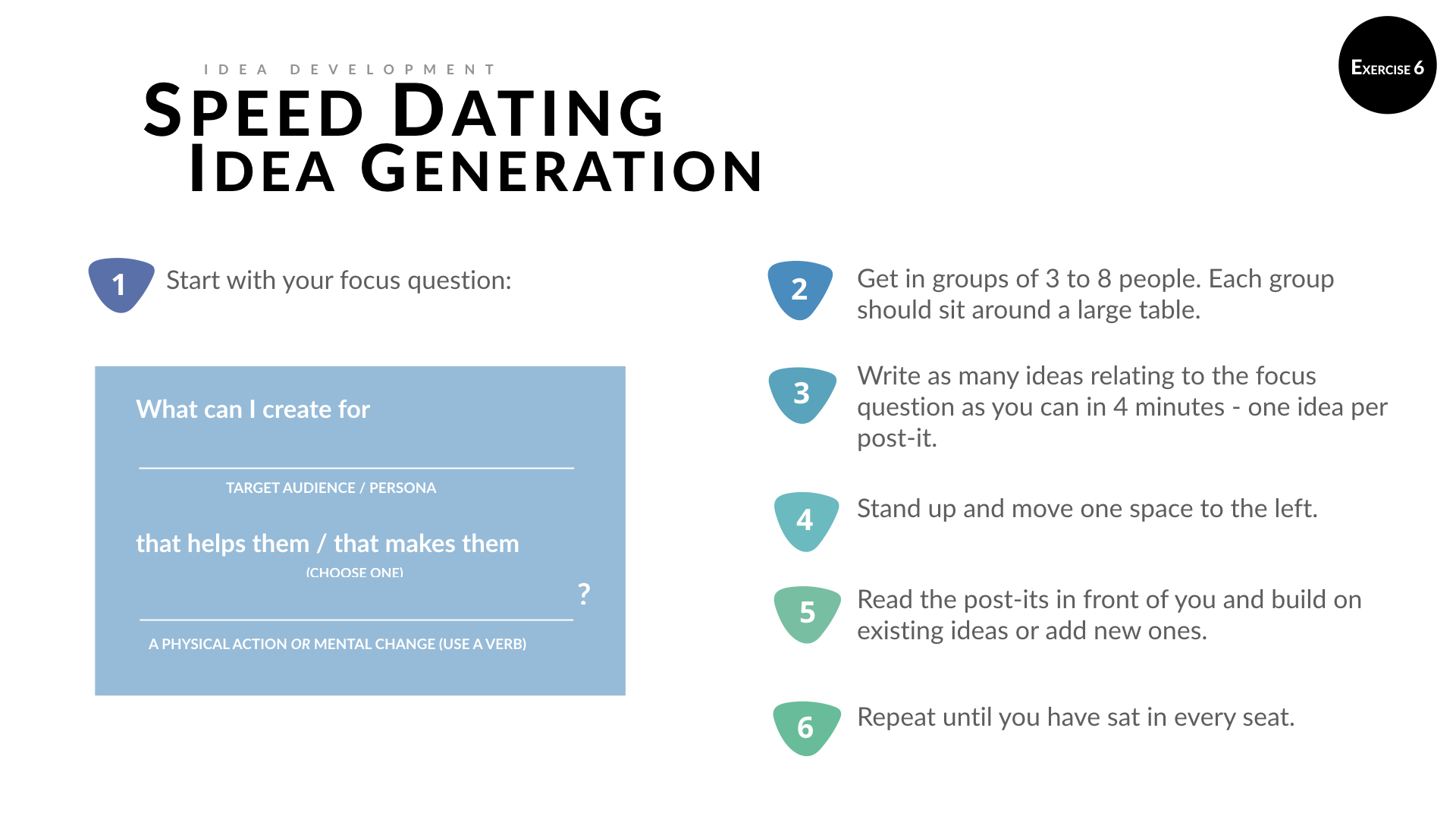
Constraints: Building off the “Party Game” creative principle exercise this idea generation method encourages participants to think big and without constraints. Within wild and ridiculous ideas we can often find originality.
Role Play: This exercise helps participants approach the focus question with diverse perspectives through the lens of popular characters.
Speed Dating: The best exercise for generating hundreds of ideas quickly. As each participant working in silence it also creates an environment where more introverted personalities can comfortably add their thoughts. The exercise enforces teams to build on each other as they read each other’s ideas.
SELECTION
Selection Criteria Tool: Having suspended critical judgement whilst generating hundreds of ideas, it’s now time for each participant to surface the concepts with the most potential. The QBD selection criteria tool helps give more meaning to the choices made.
Once everyone has marked their favoured ideas with the appropriate letters team leads can decide whether they are looking for ‘quick and easy’ ideas or more ‘speculative yet breakthrough’ concepts to focus on in the rest of the workshop. Usually each team will take a maximum of 3 ideas into the enrichment phase.
ENRICHMENT
Enrichment Sheets provide the team with guidance to develop a concept scribbled on a post it note into a more fleshed out solution. Usually we would give each team at least an hour per idea to fill in the enrichment sheet. This is their chance to brainstorm further, do some ‘quick and dirty’ research online or with target users if they are nearby and plan out how they could introduce this idea into their roadmap once they leave the workshop. The teams are expected to present these sheets to all the other teams at the end of the workshop.
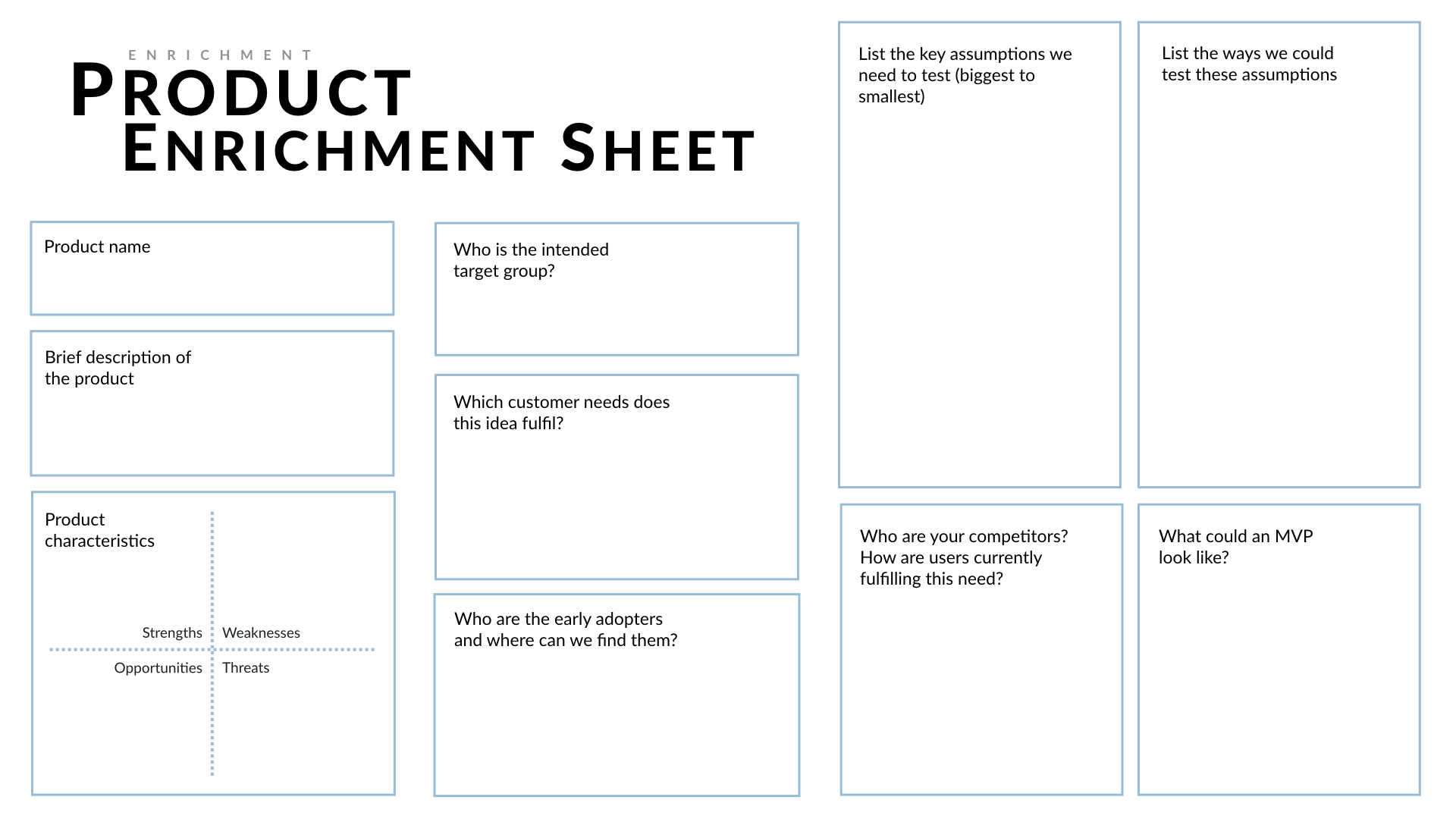
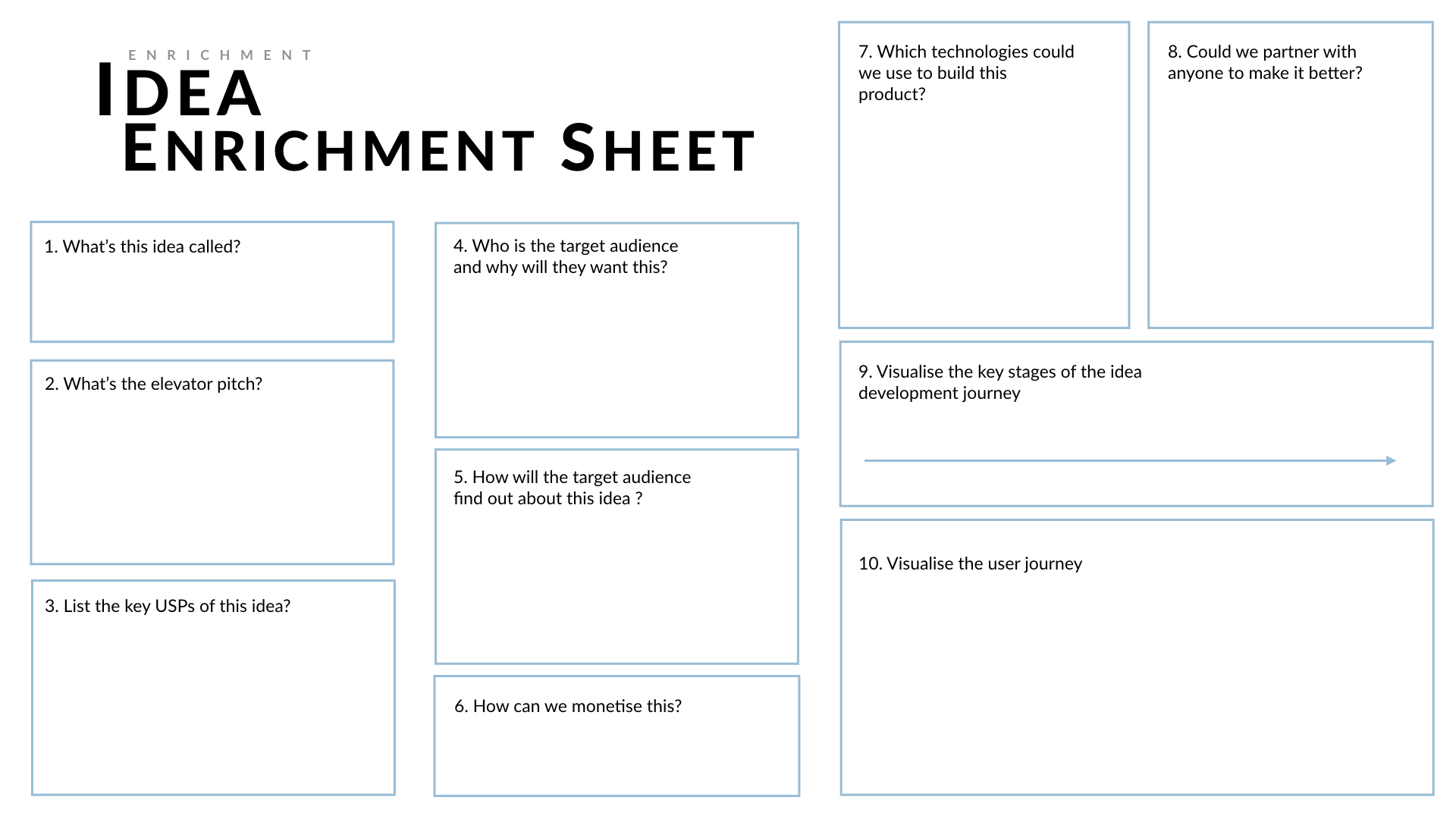

Enrichment sheets can be tailored to the brief, organisation or workshop goals. Here we can see three sheer examples the first for teams generating product ideas, the second for teams generating general ideas campaigns and the third for ideas that need to work within corporate environment.
IDEA PRESENTATION
The teams now give a short 5 minute presentation of their work in progress enrichment sheets to the other teams and leaders. They then receive feedback from which they are asked to identify some aspects of the idea to focus on after the workshop.
This workshop has provided the teams with the tools and early ideas to then further iterate upon and share with the larger organisation so they can develop and test prototypes in proceeding days.

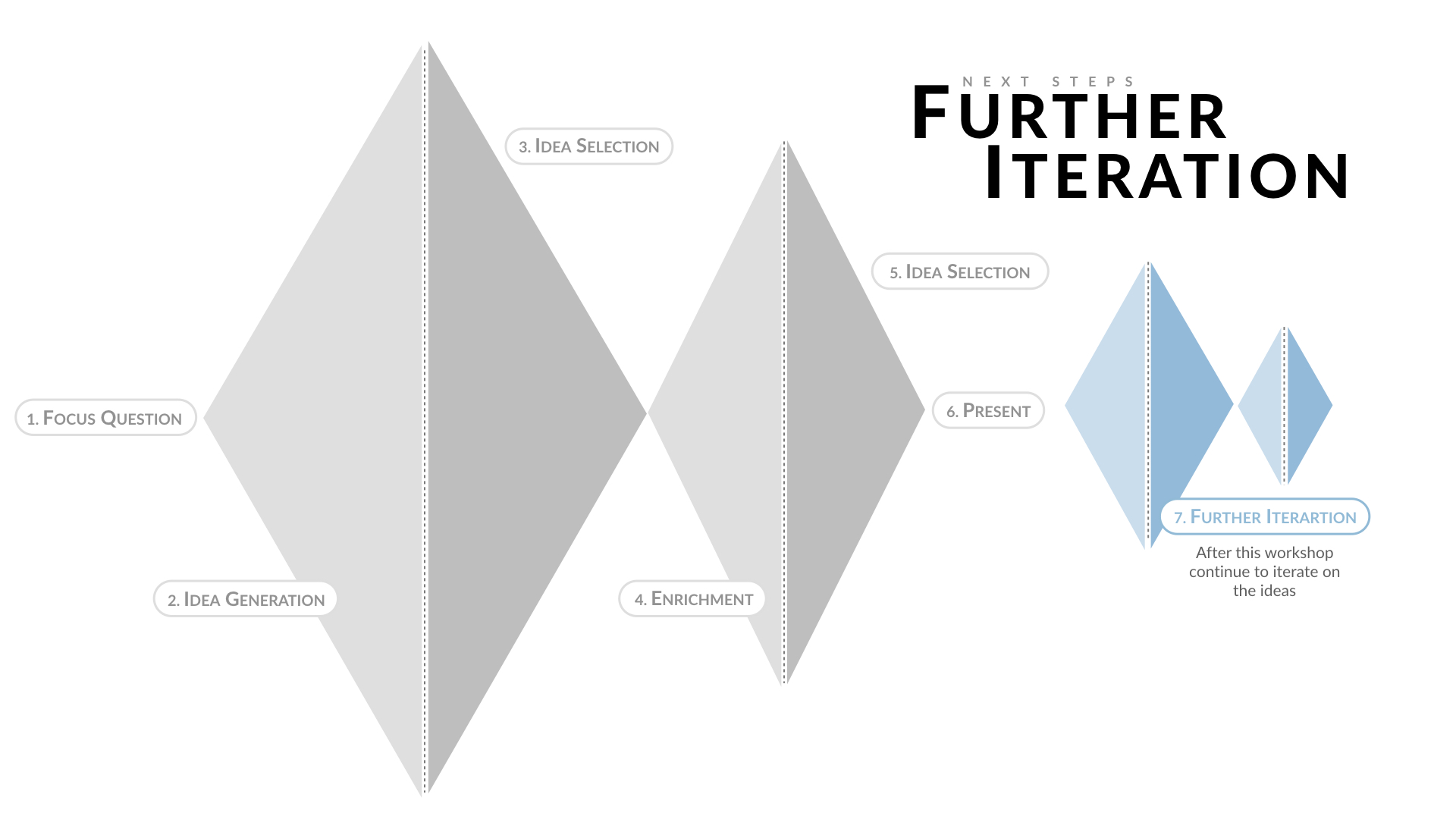
REFLECTION & cHECK OUT
The workshop finishes with participants refocusing on their questions from the start of the workshop. 90% of questions are usually taken down displaying the value that the participants have taken from their efforts and any final thoughts or remaining questions are discussed.
